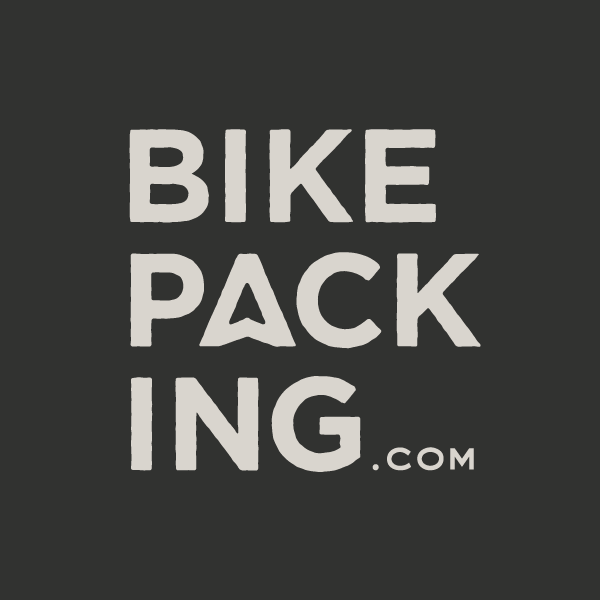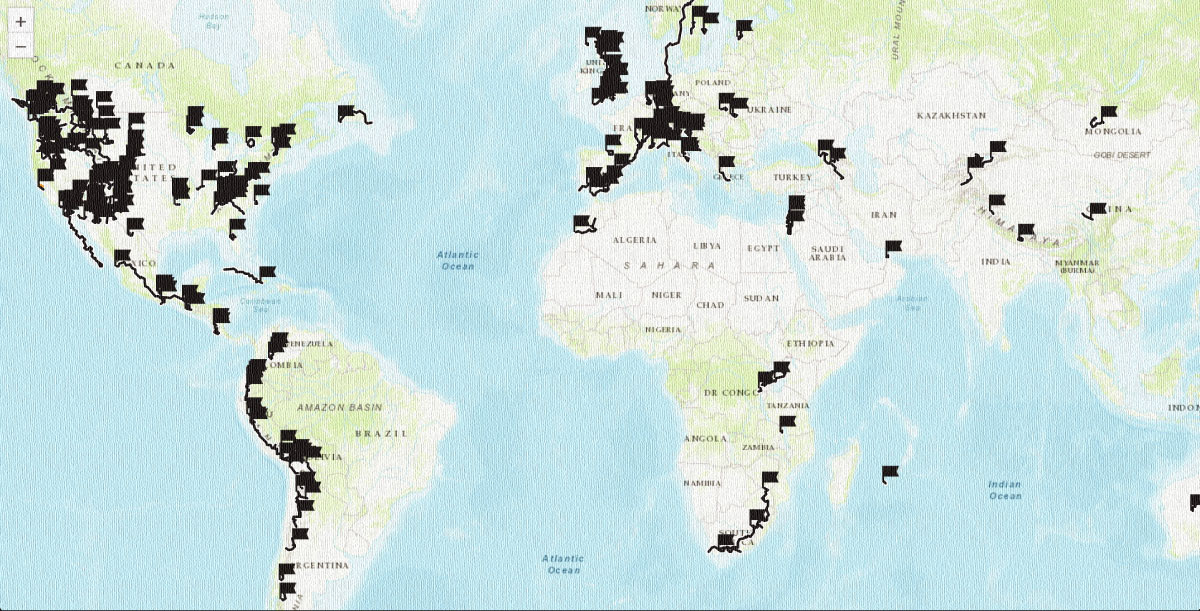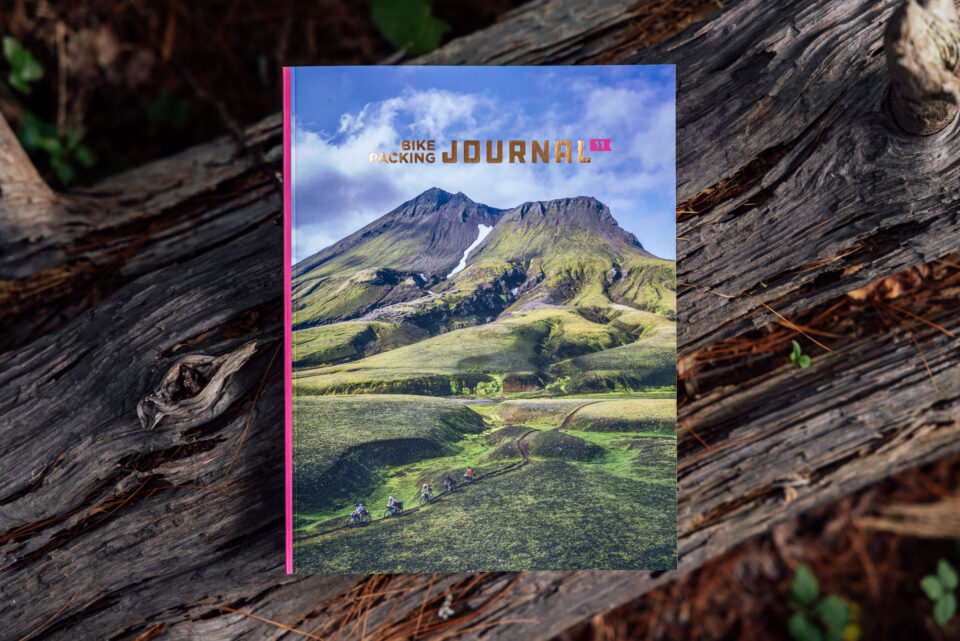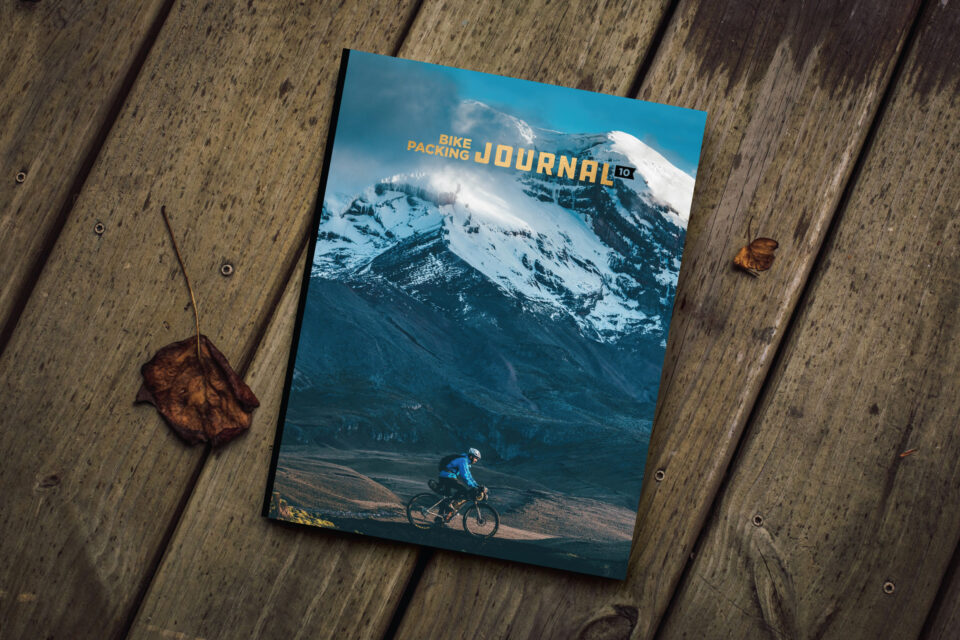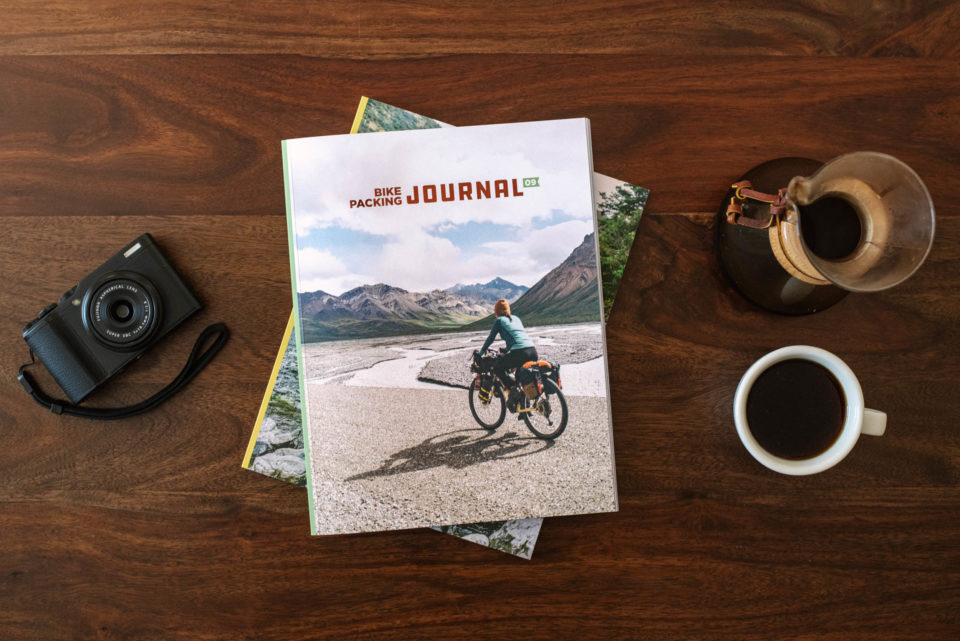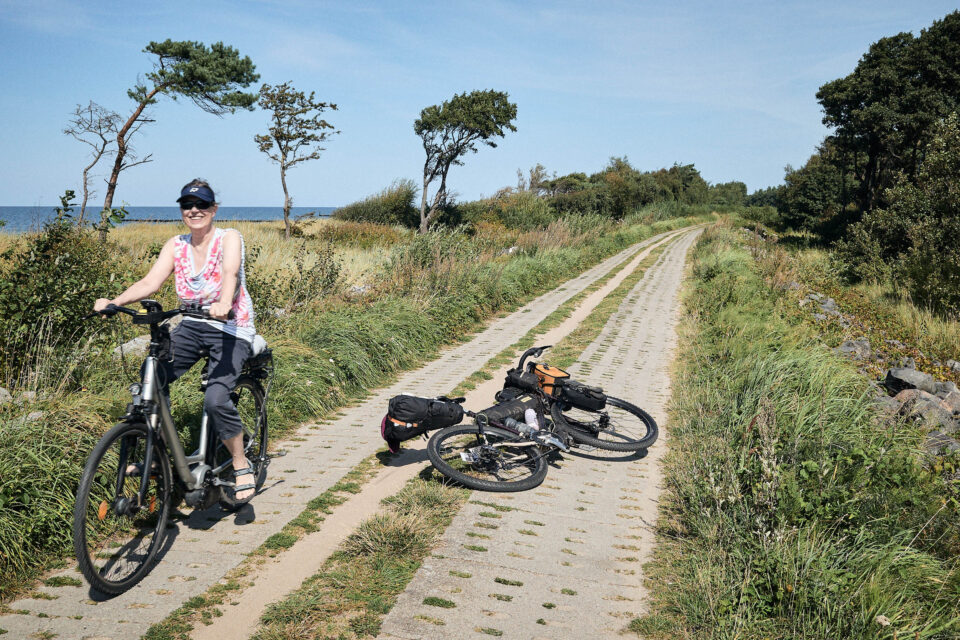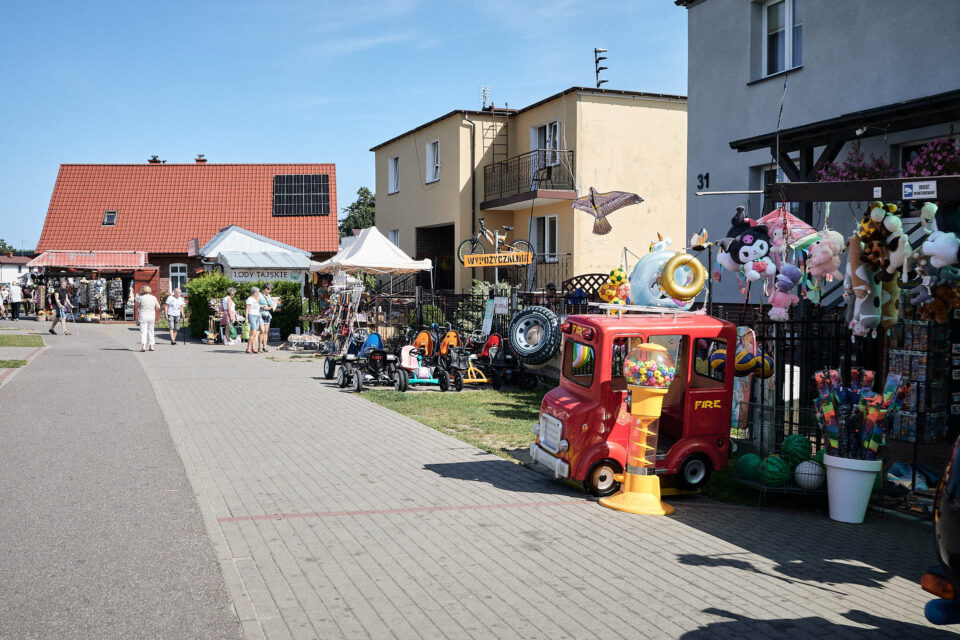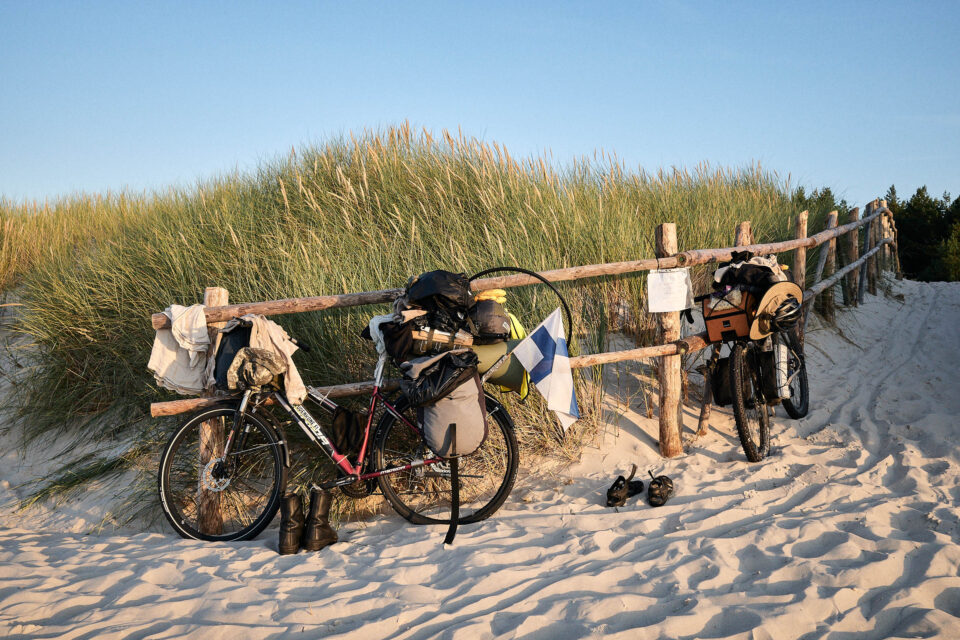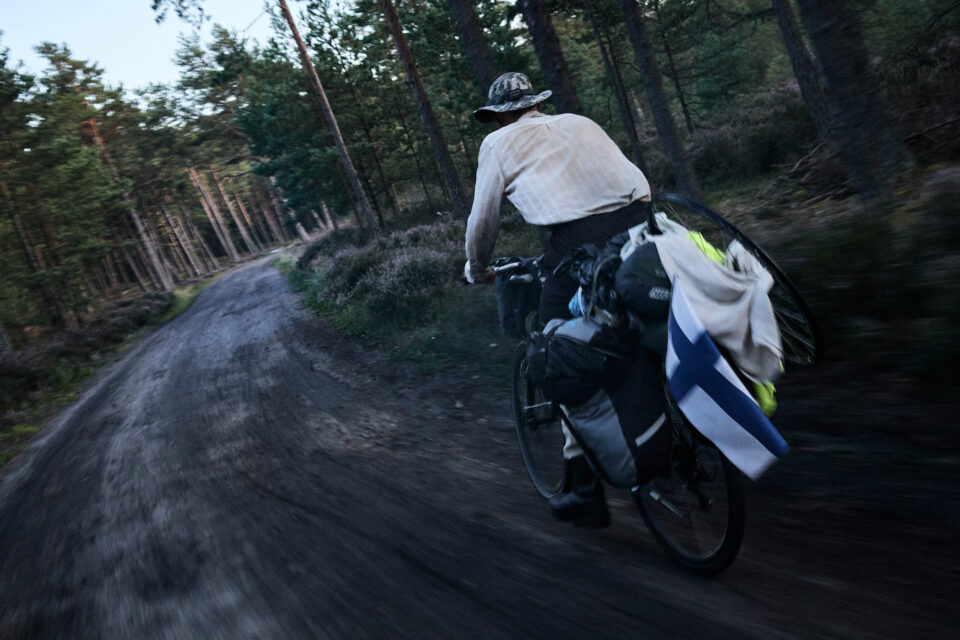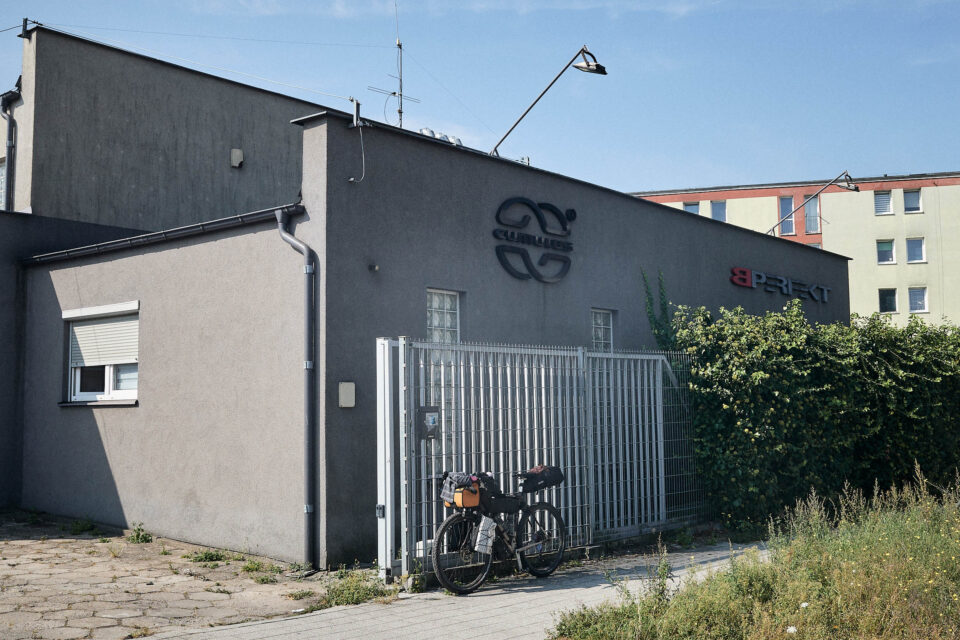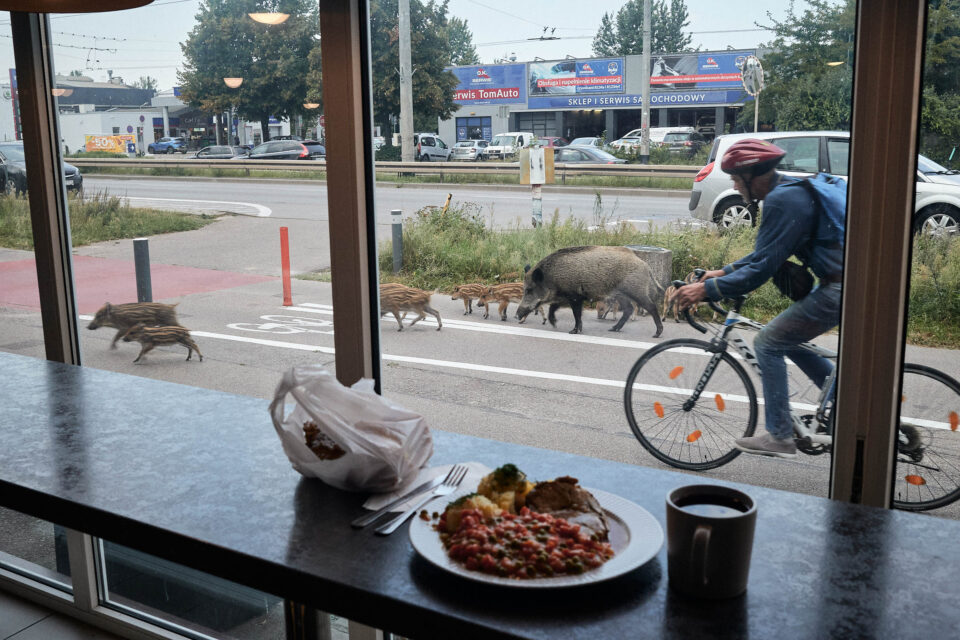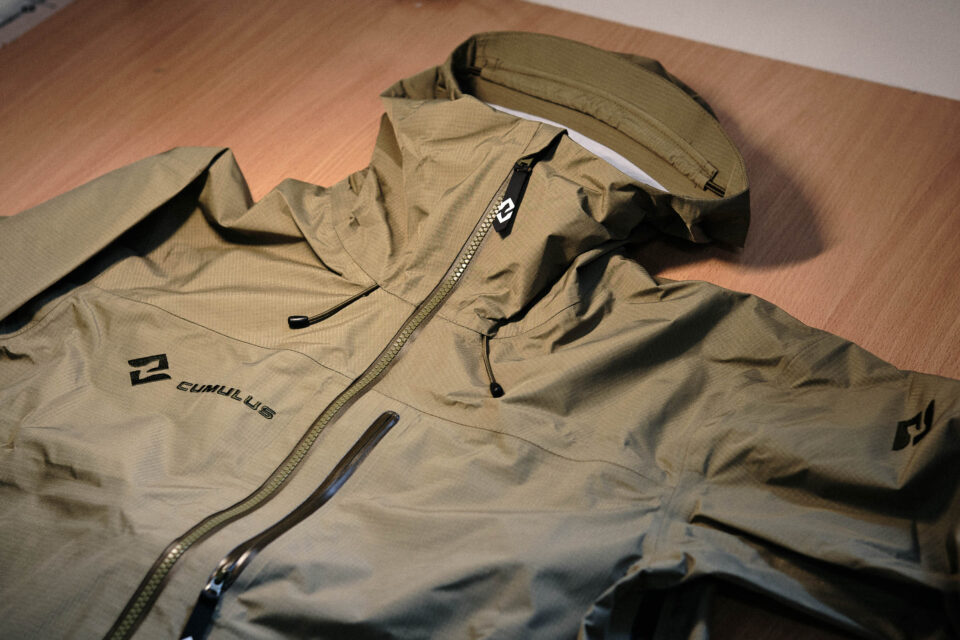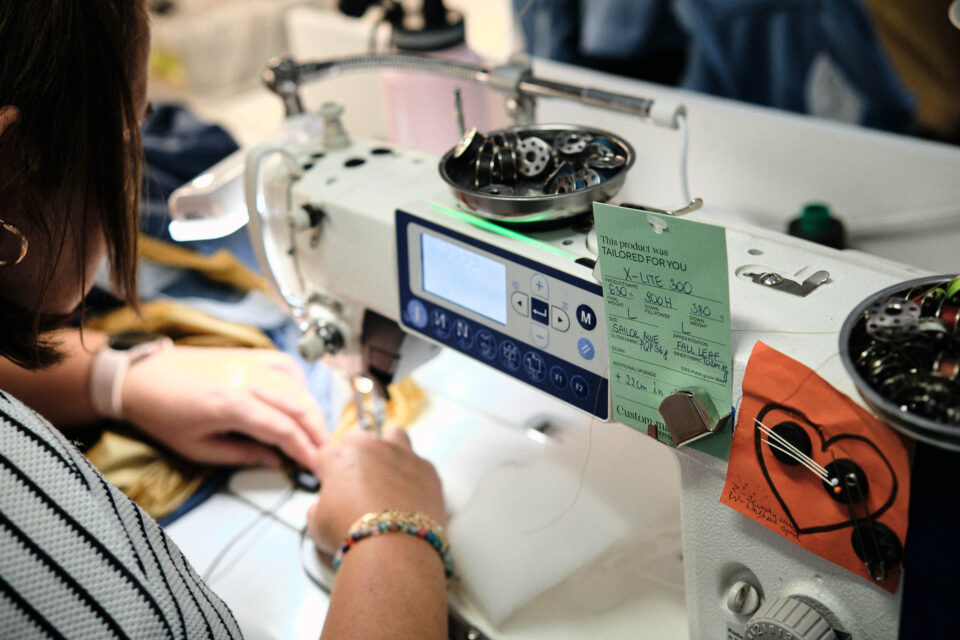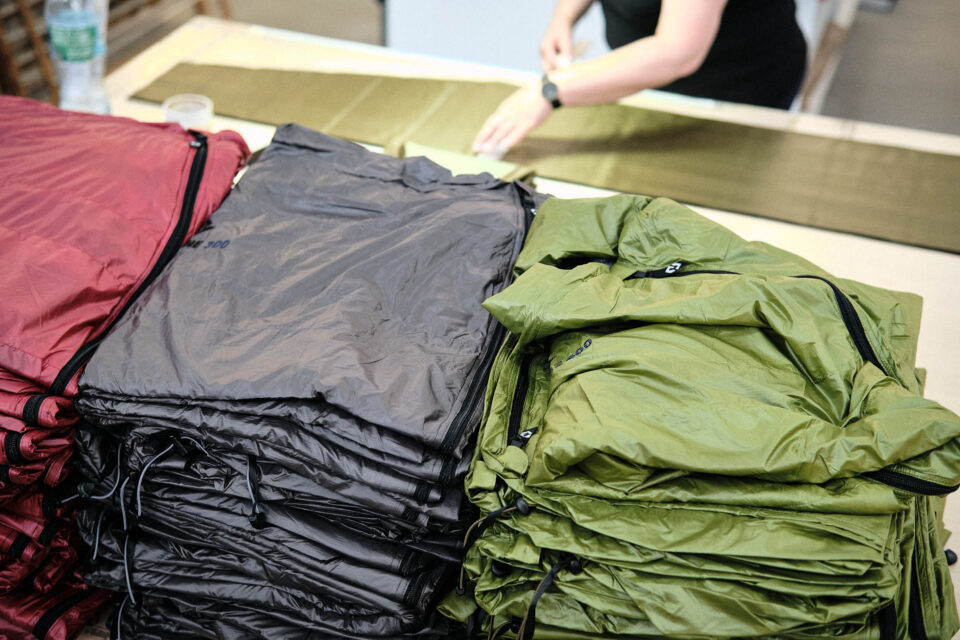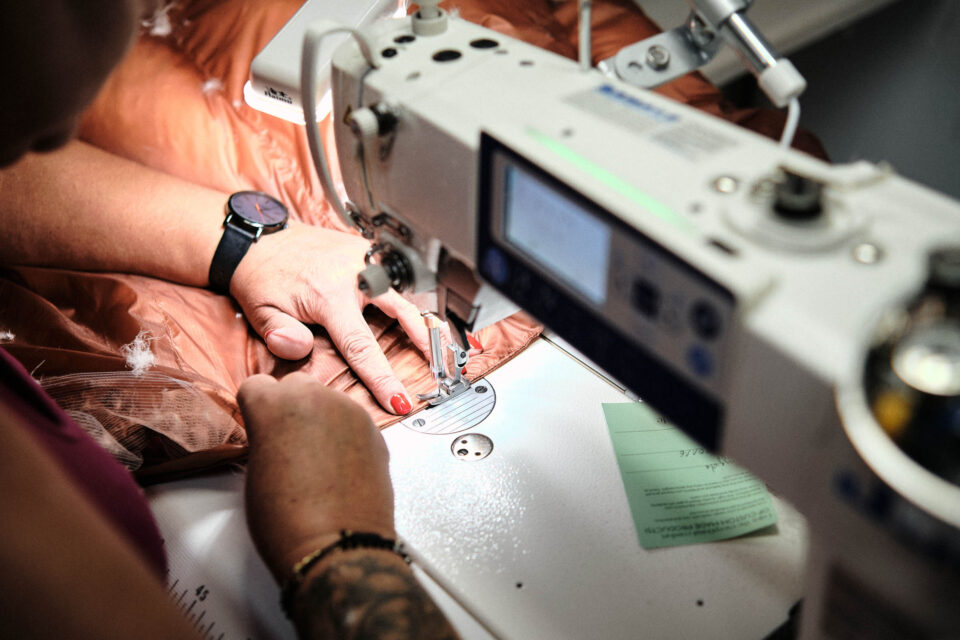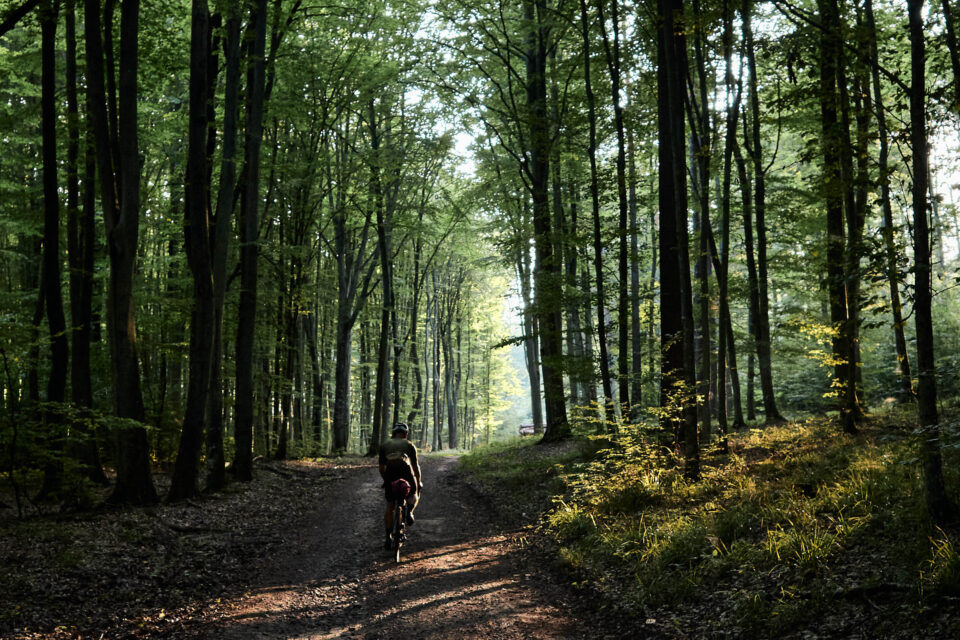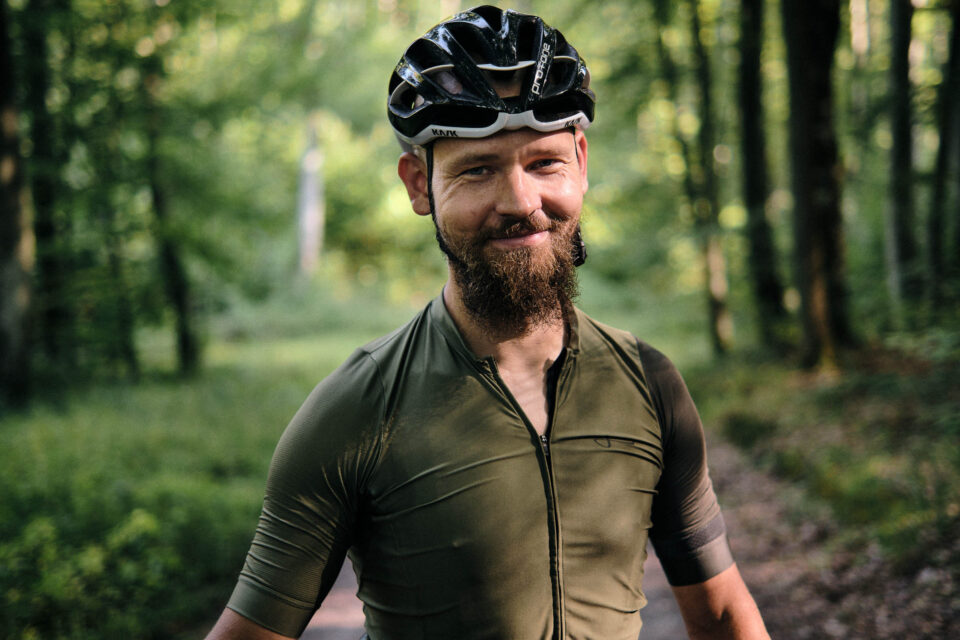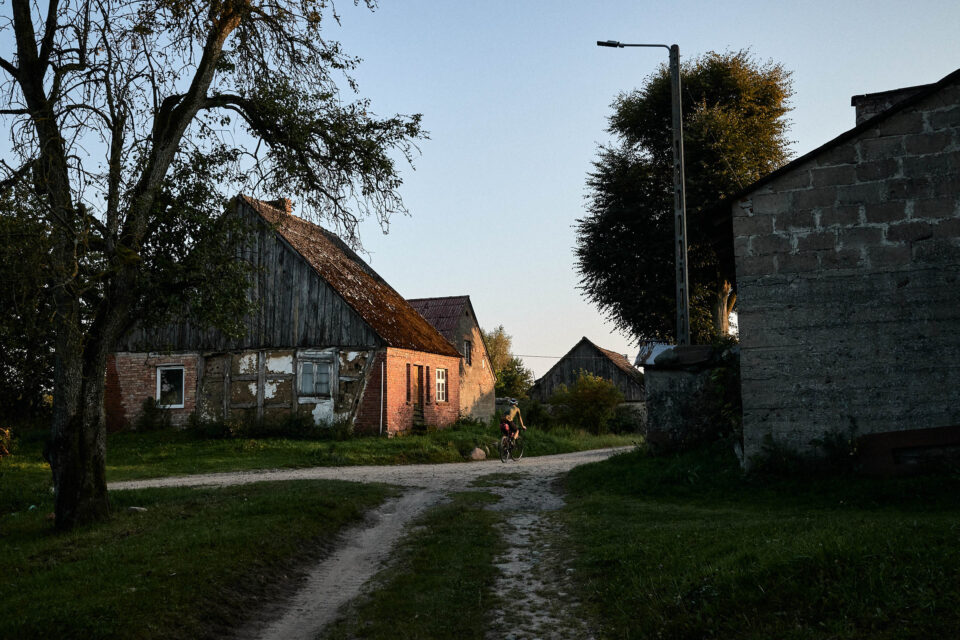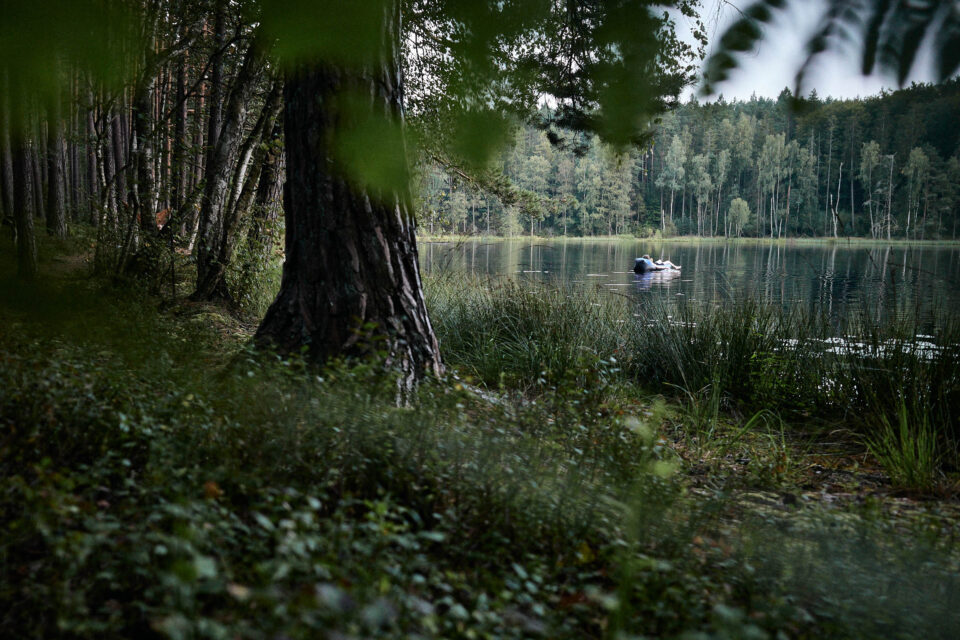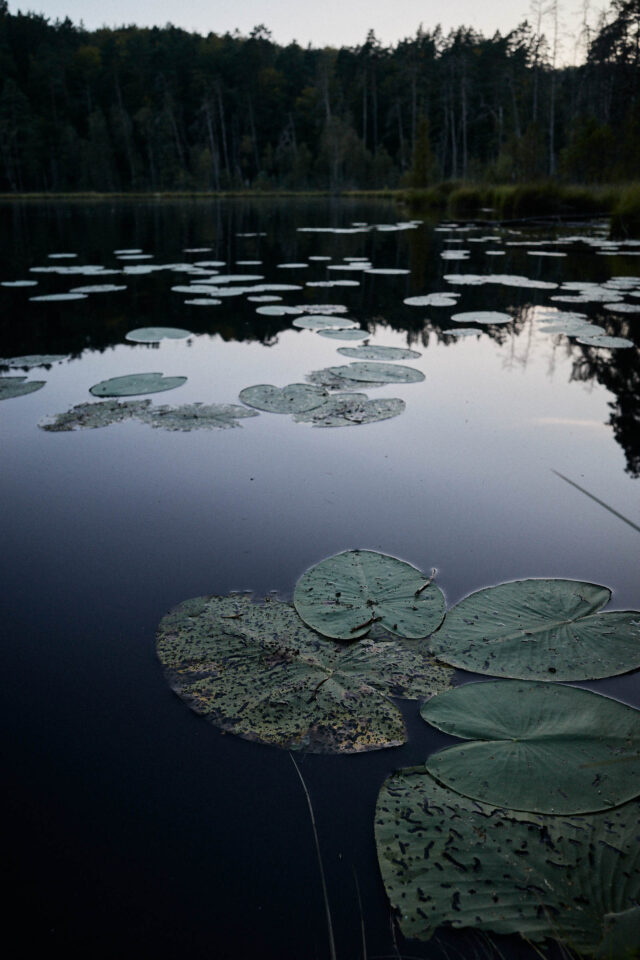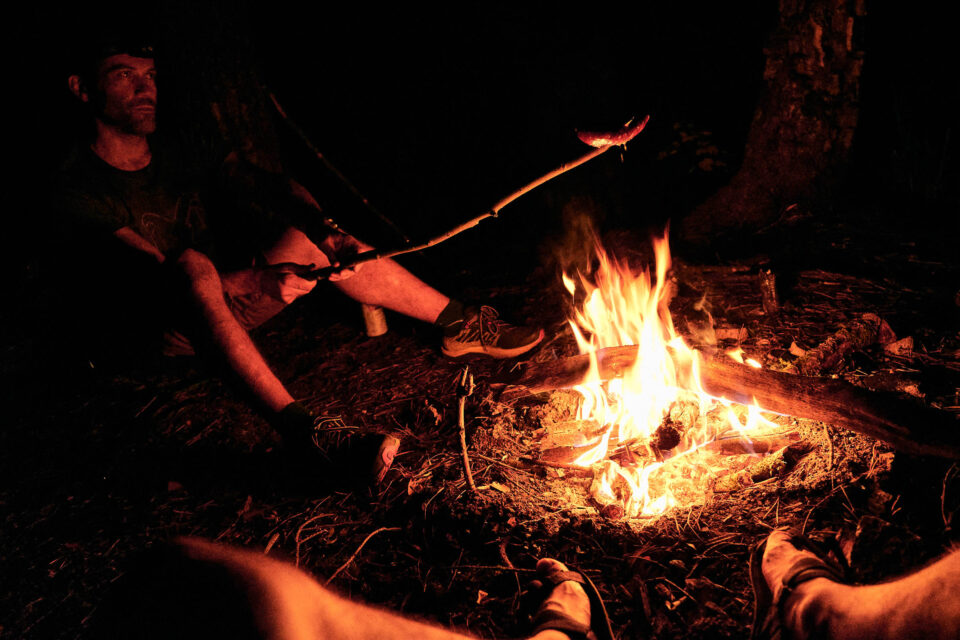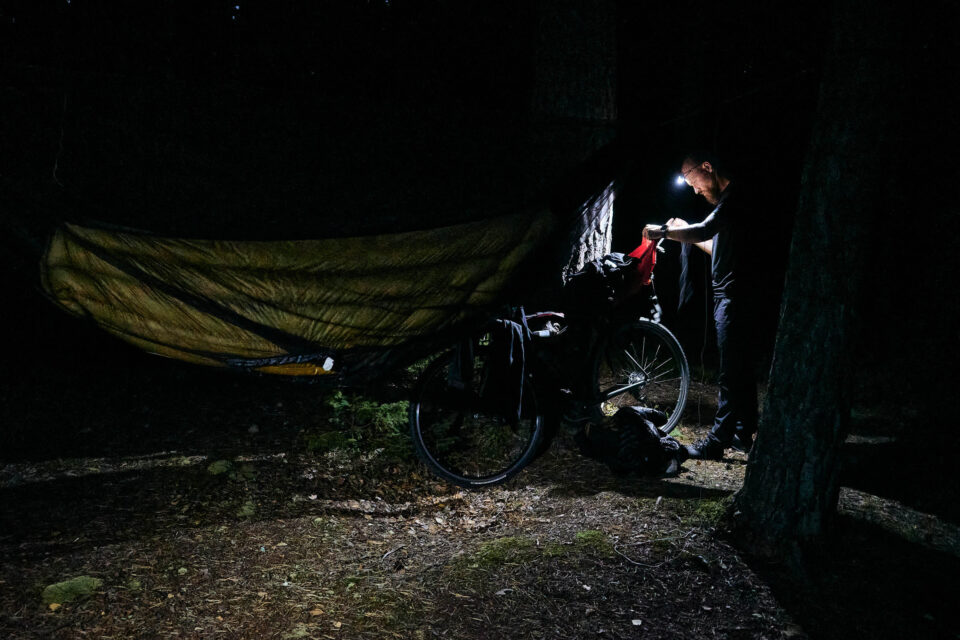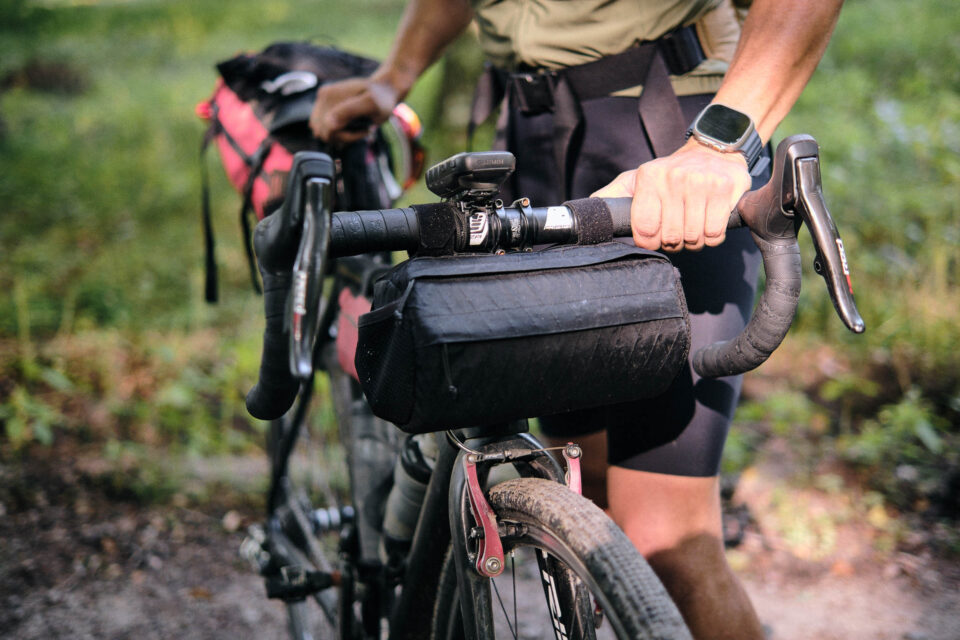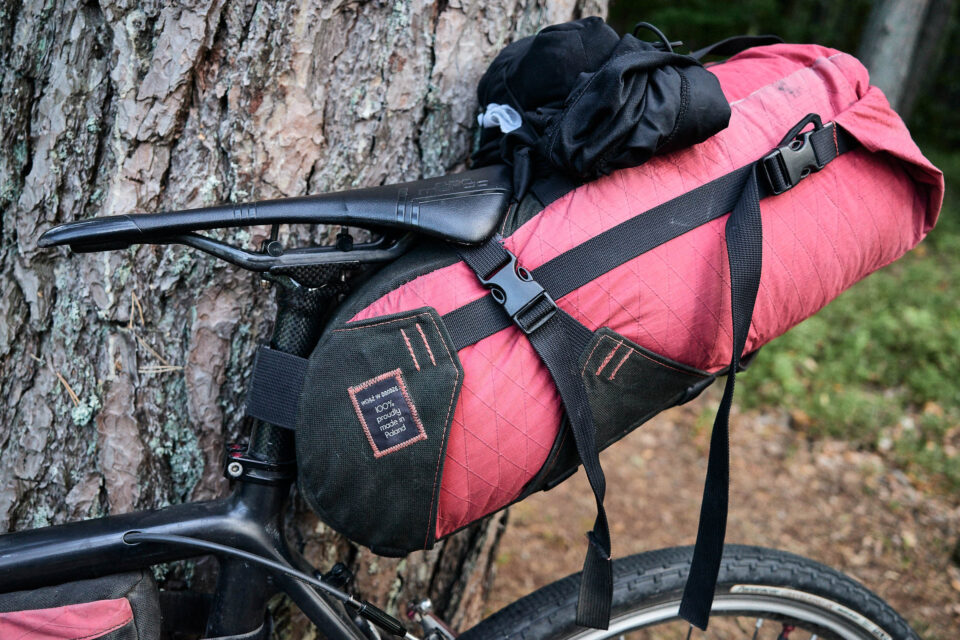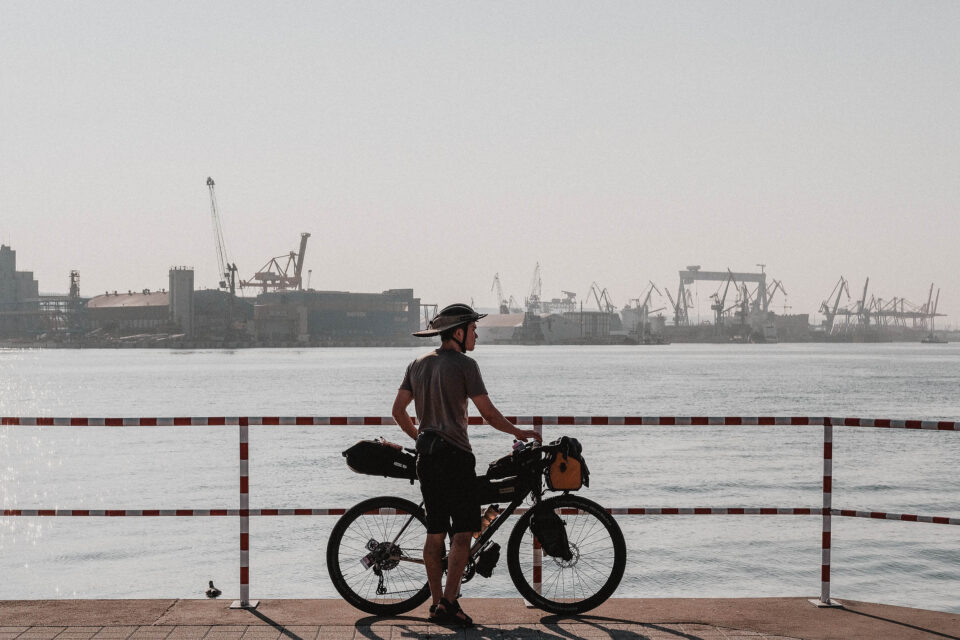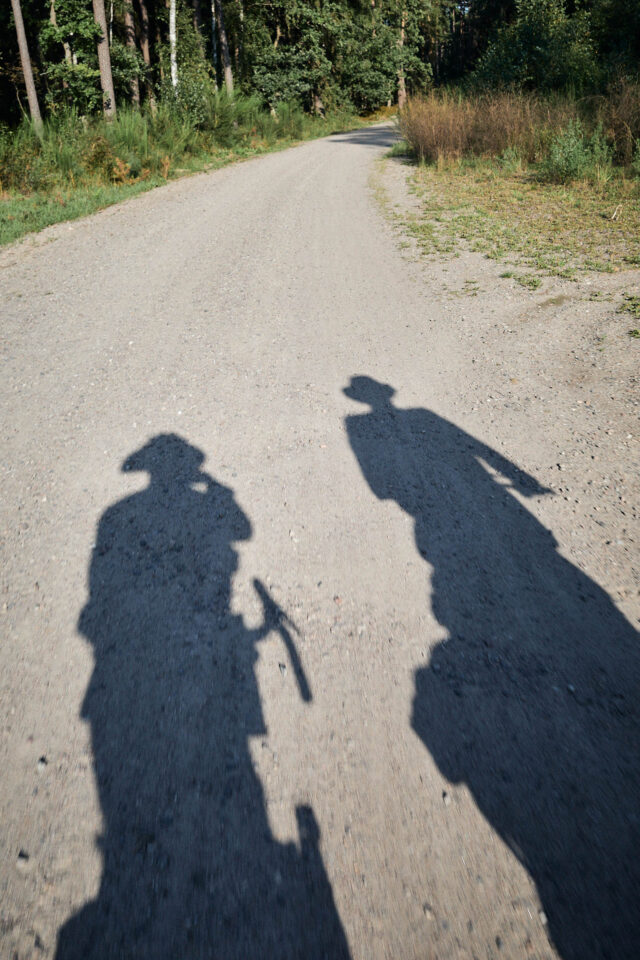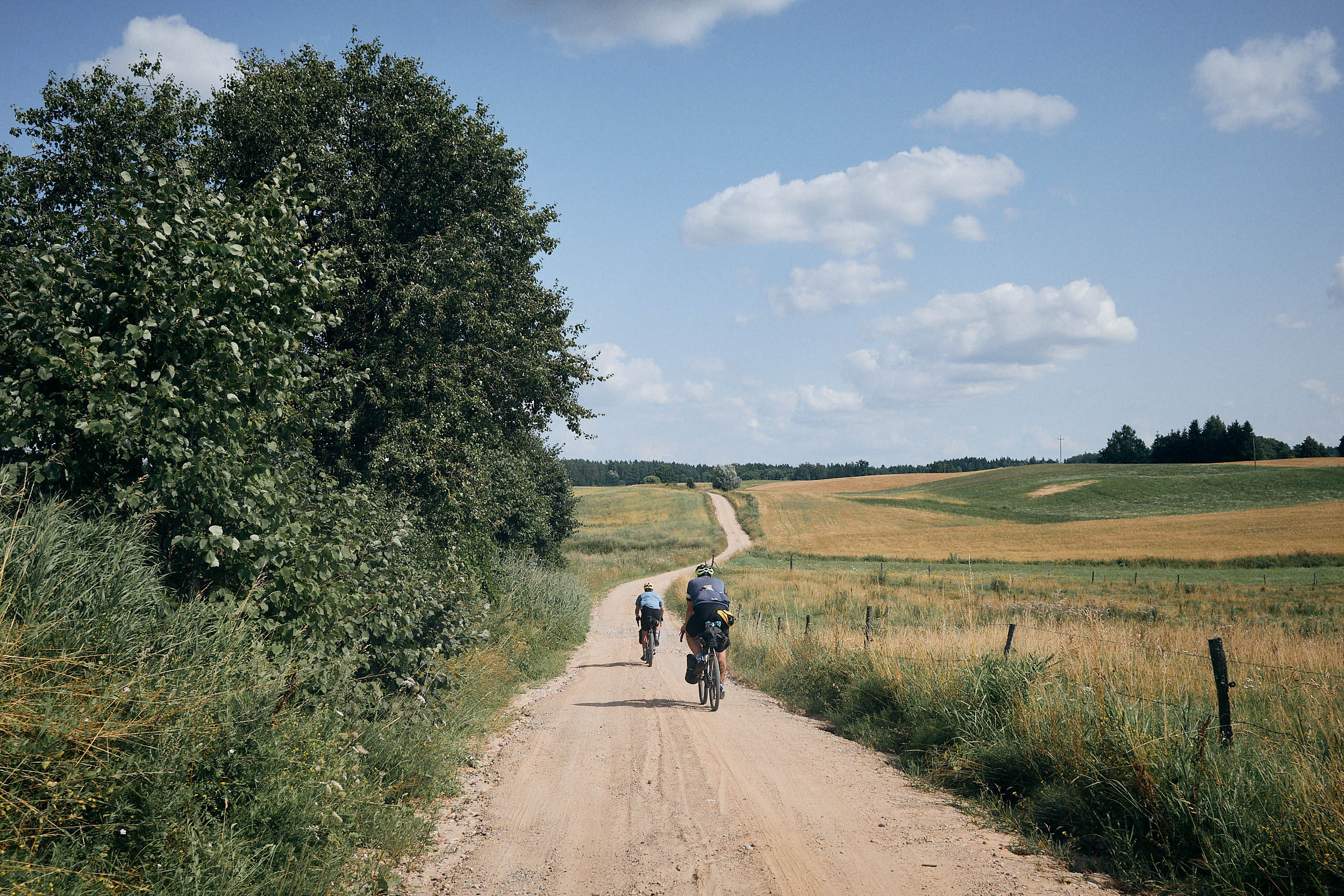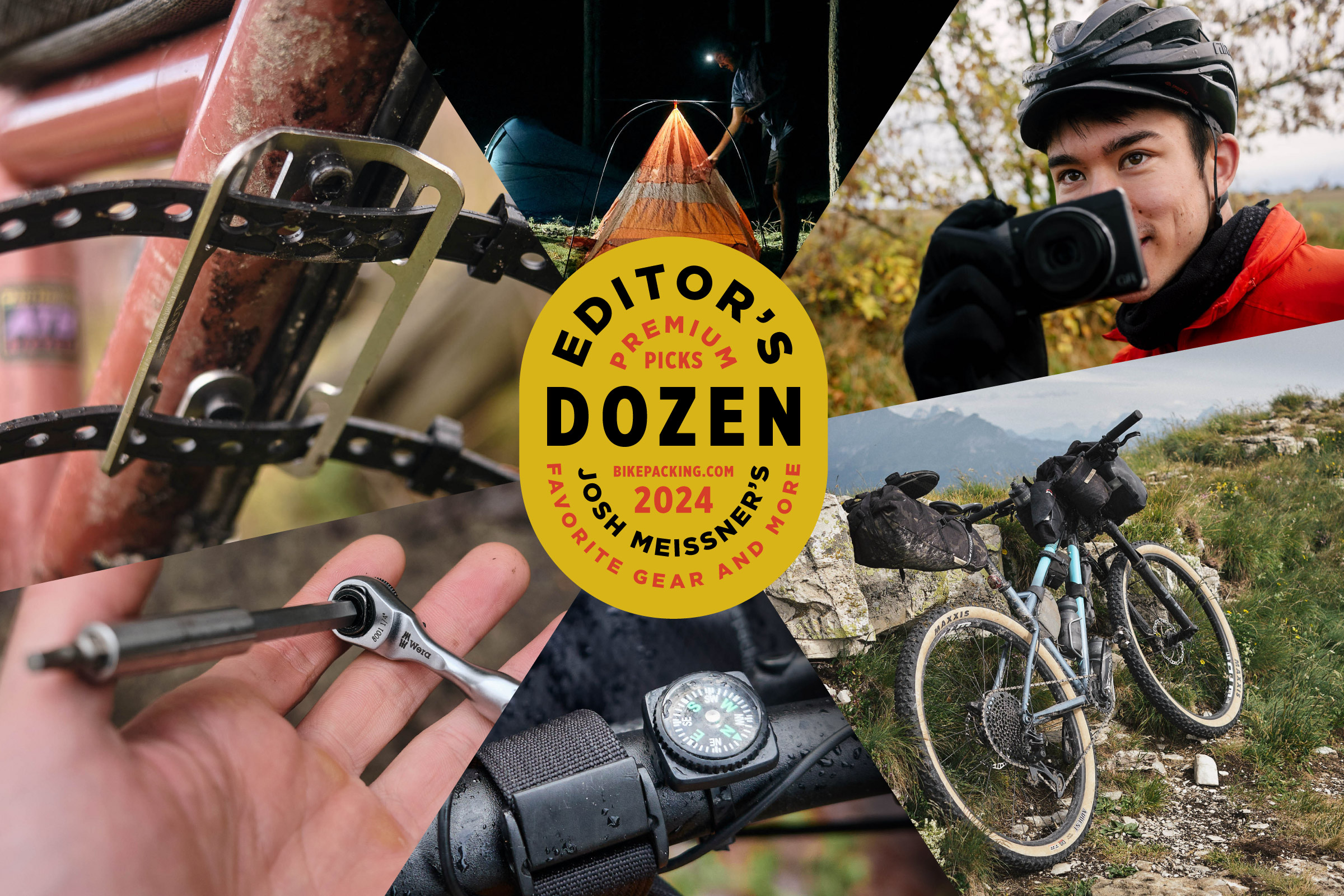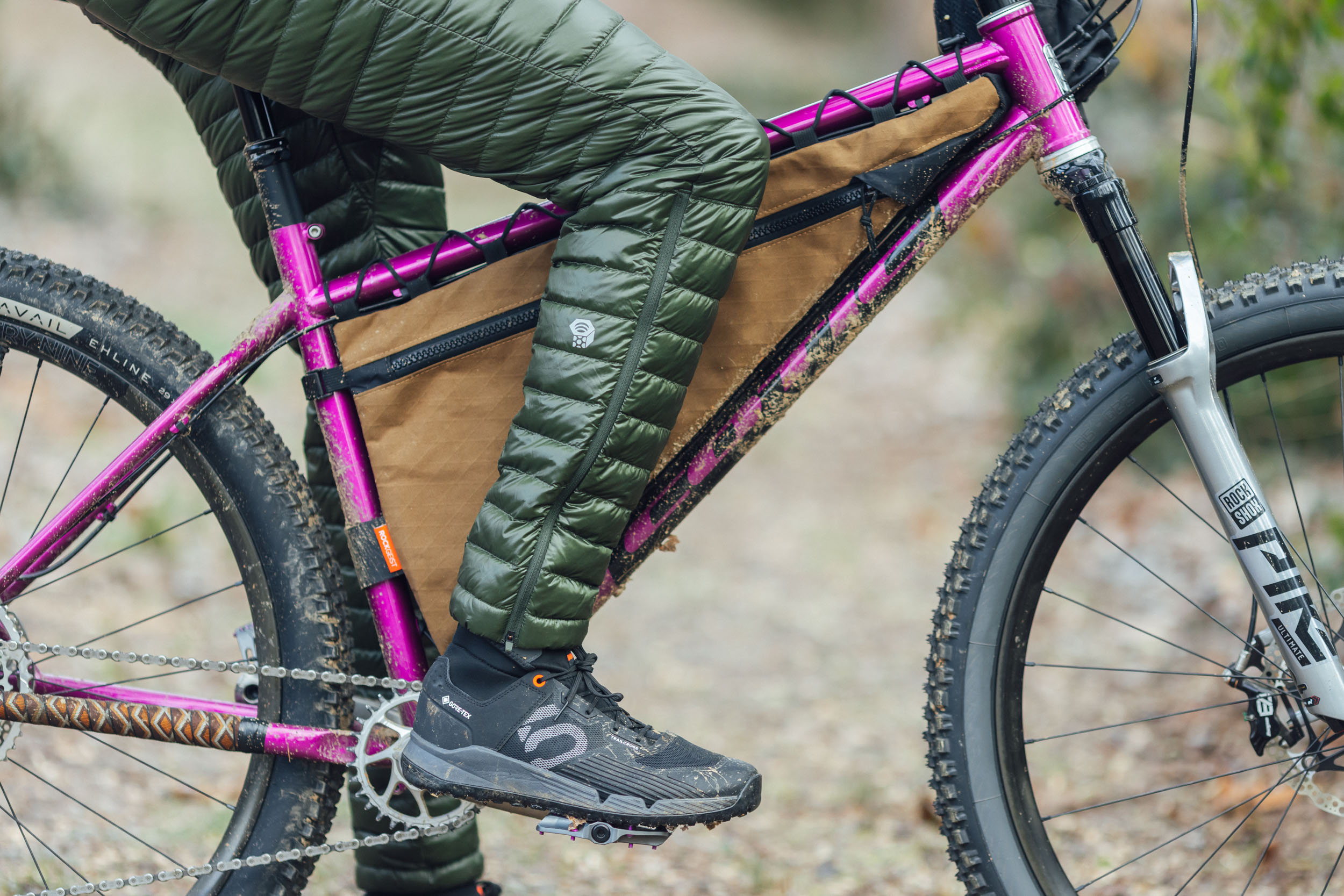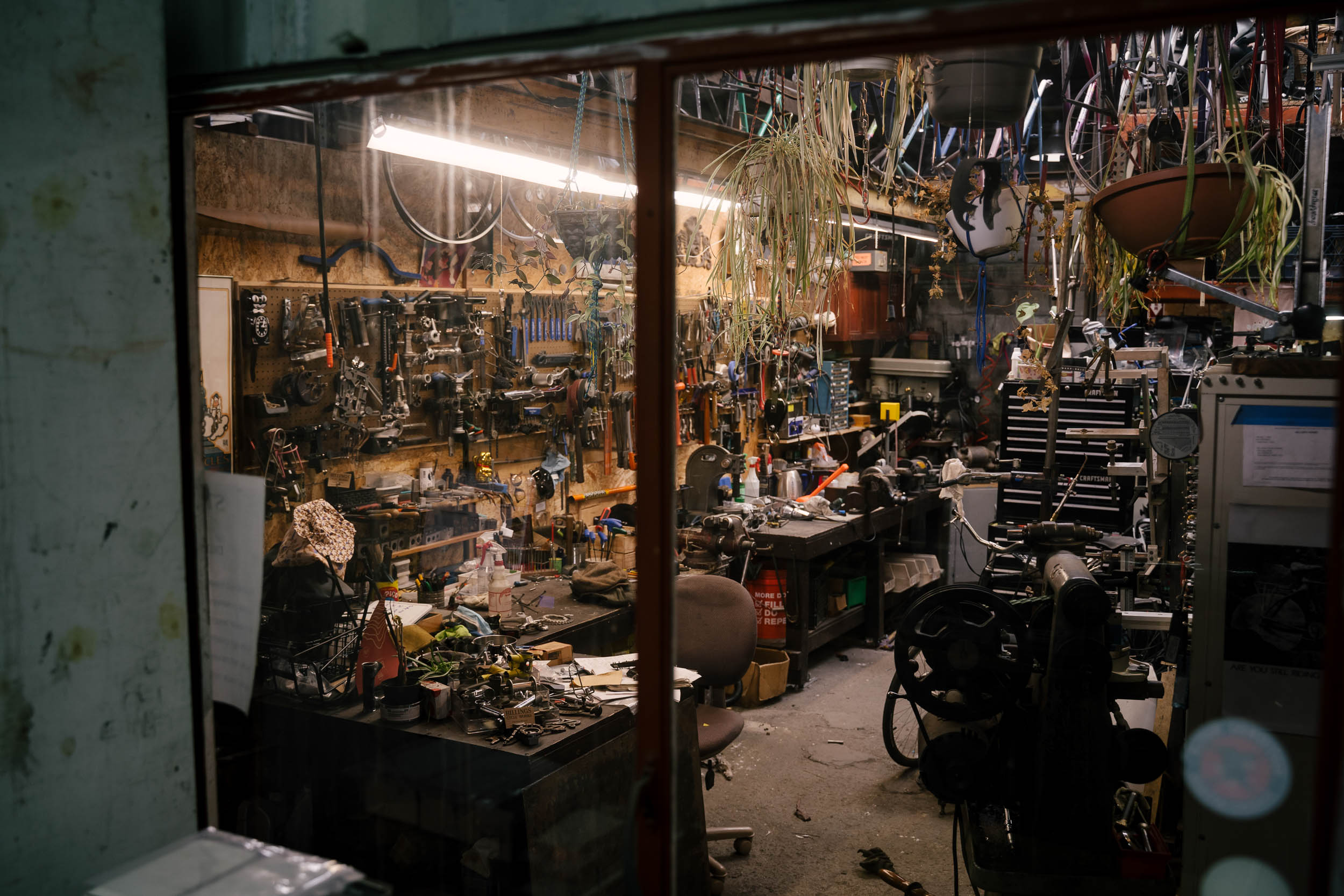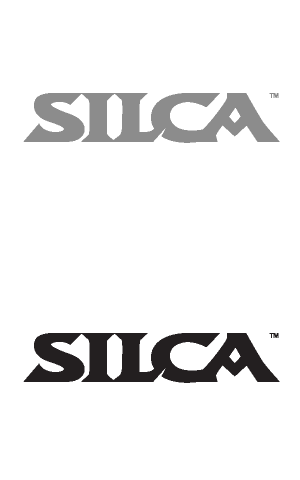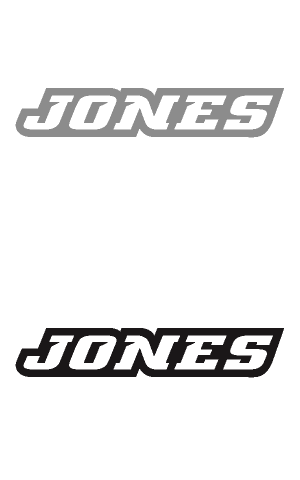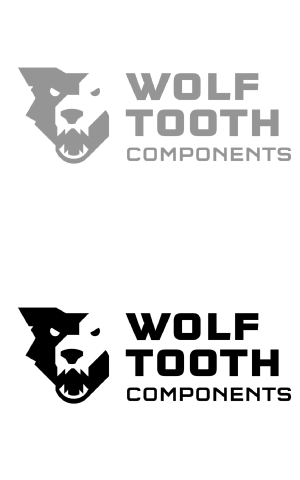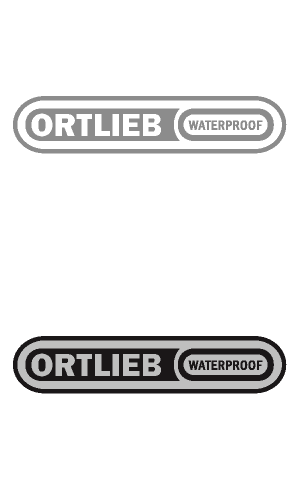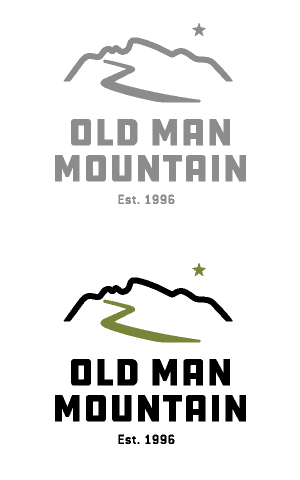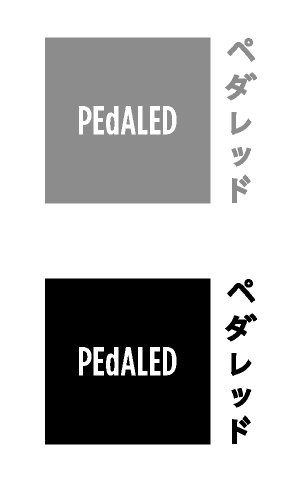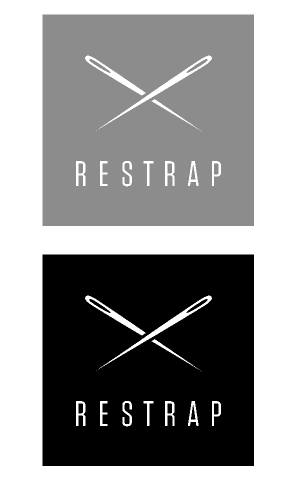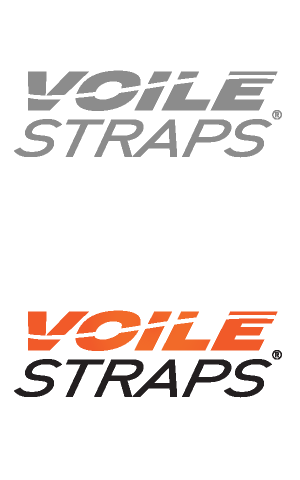Inside Cumulus: Down Town
What’s a sleeping bag beyond goose down in a nylon shell? A whole lot more, as Josh Meissner found out on a ride to Gdynia, Poland, where he connected with the passionate folks behind established ultralight manufacturer Cumulus Outdoor. Settle in for an exclusive tour of their factory and go-to overnighter spot, thoughts on the nuanced ethics of down, and a relational take on local production and repairability, all set against a lovely backdrop of summer on the Baltic Sea…
PUBLISHED Feb 10, 2025
In summer, I find myself riding along Poland’s Baltic Sea coast, and it’s as surreal as I remember it from my tour up to Norway and back three years ago. Fast dirt through national parks and cement-slab causeways punctuated by copy-pasted beach towns with waffle stands and ice cream and arcades and more waffle stands. I sleep cradled by the dunes as windswept pines stand watch above me. In the morning, I push my bike barefoot through the surf, escorted by squadrons of cormorants. I stumble into an ornithologist camp, where I get to release a young reed warbler, tiny and fragile in my hand.
Back on the road, eastbound on the Eurovelo 10, a booming voice rolls up on me, “Hello, where are you going!?” It’s a young chap with an enterprising gleam in his eyes, clad in long linen and a camo boonie hat, piloting a terrifyingly overloaded trekking bike. “Gdynia,” I say, “and you?” “Home,” he says, a Finnish flag flying proudly off the rear. Let’s call him Lauri. He’s been touring Scandinavia for three months, and I get the sense it’s loosened more than just his rack bolts.
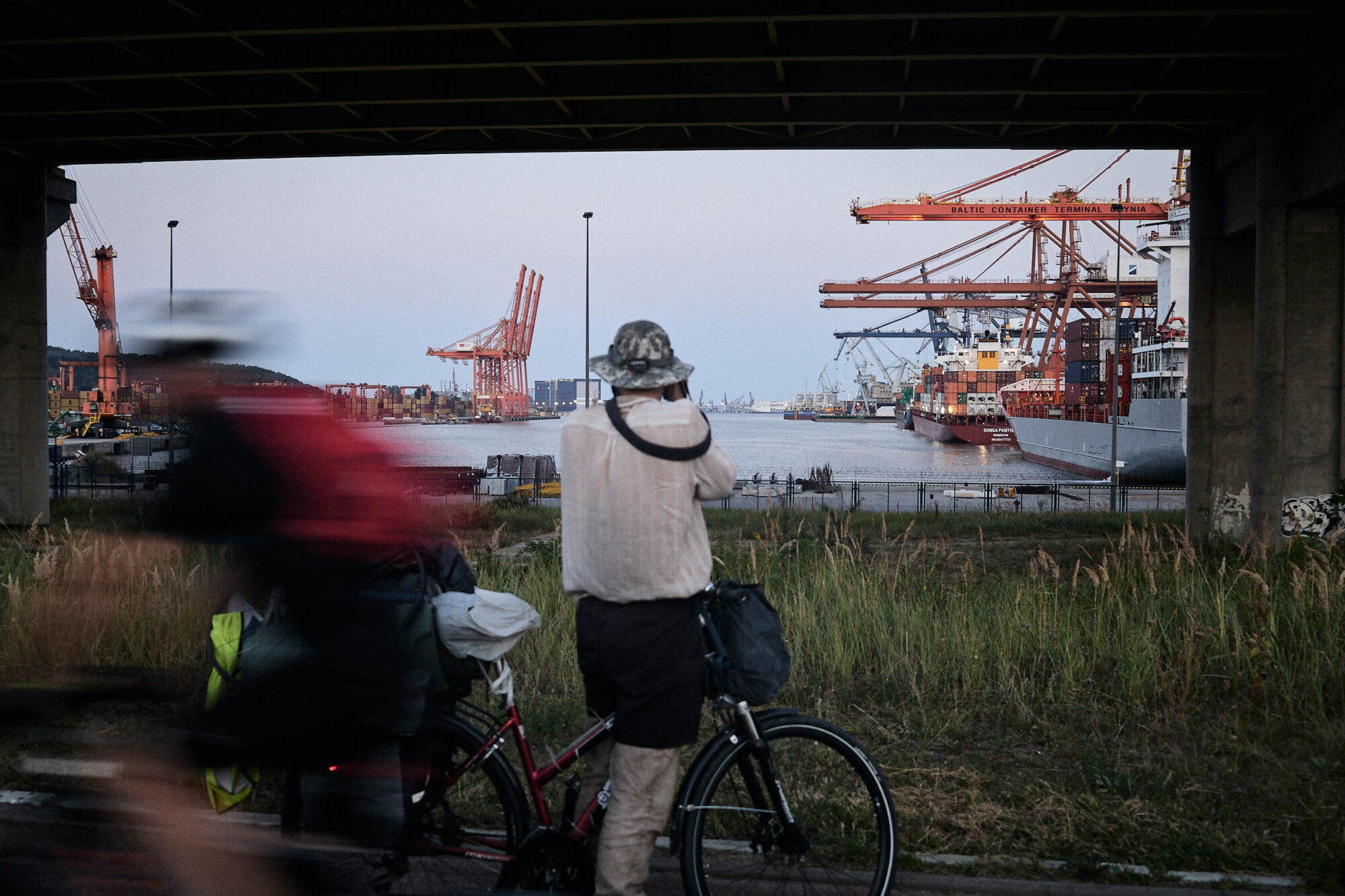
Lauri and I ride together for three days that feel like three weeks, keeping the Baltic Sea on our left. We swap bikes and stories, eat waffles, play air hockey in the arcades, and swim in the sea. We bivy by the beach, him in his military surplus sleeping bag on two foam pads, me in my ultralight quilt. When I asked him about the broken rear wheel dangling from the back of his bike, he said, “Well, you know, leave no fallen soldier behind!” Busting a spoke on the replacement wheel each day, he’d happily brew up on his battered Trangia while sitting down for the repair. Lauri’s love for his old gear borders on obsessive sentimentality, and it puzzles and embarrasses and inspires me.
Headed for Down Town
I was drawn east to meet the team behind Cumulus Outdoor in Gdynia, as I wanted to see where and how the quilt I’ve been bikepacking with throughout the last seven years was made. The size of a pomelo when packed, it gets incredulous reactions from folks who haven’t been initiated into the cult of ultralight. That tiny thing?! Yet it reliably keeps me warm, enabling me to sleep soundly in nature around my home in Berlin and from Finland to Spain. I take it for granted.
Thinking back to my bikepacking beginnings, I remember Cumulus coming up on German ultralight forums as a reputable manufacturer of high-quality and, particularly relevant for me at the time, high-value down equipment. The fact that they were made in neighboring Poland was nice too. It didn’t occur to me to try an old sleeping bag first; I needed the best up front, or at least the best I could afford on a student budget.
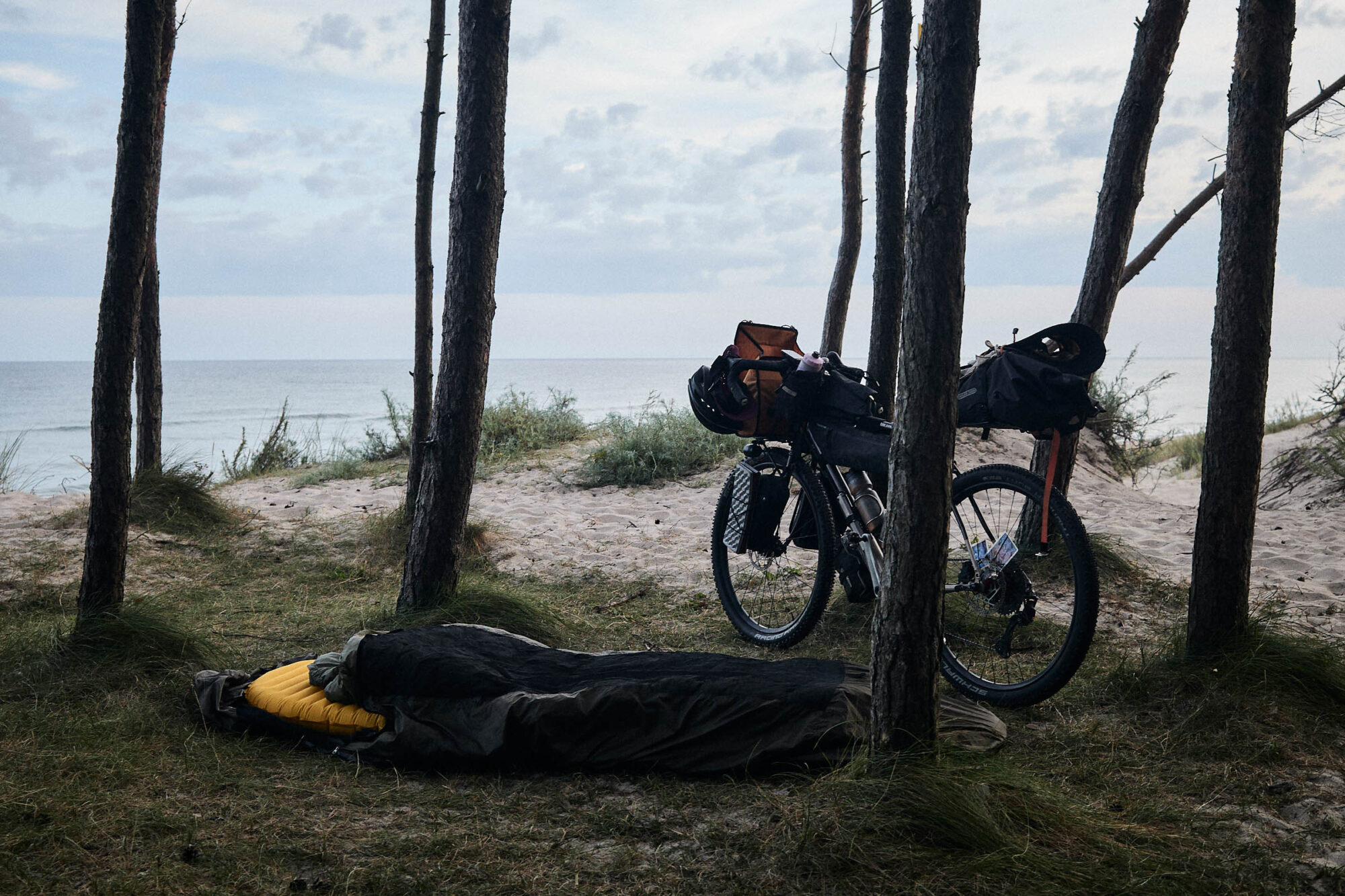
Gdynia is a city built around its port, all human activity squeezed into a loud, narrow strip between the sea and the hills. The contrasts and textures are just a little grittier than I’m used to. At the Cumulus headquarters, a small two-story building among communist-era apartment blocks, I meet Grzegorz, or Greg, an avid thru-hiker who takes care of marketing, and Rafał, who makes up the one-man product team and wears many other hats. We’re soon joined by deputy CEO Jacek, who I meet as a direct, serious man with a smile that’s faster than my shutter, and Anna, who handles the brand and communications. Together, they walk me through their products, sustainable practices, wetland conservation, 1% for the Planet contributions, and earnest passion. It’s a hot day, and the ceiling is low. I imagine we’d all rather be outside.
The company’s origins go back to the 1980s. In the communist era, travel was restricted, and funds were limited. For most people, holidays were anchored in nature fairly close to home. Turistik remains synonymous with outdoor gear. Jacek’s father Zdzisław gathered experience designing tents and panniers for the state company Żagiel. He was able to travel across the Baltic Sea to Sweden, where he was exposed to Western outdoor equipment. Right after the collapse of the USSR in 1989, he seized the opportunity to found his own company. For a long time, Cumulus was a tiny operation, just Zdzisław and a few seamstresses making sleeping bags made from first-generation Pertex fabric and filled with the exquisite Polish white goose down. It is said to be of particularly high quality due to the cold winters and hot summers of continental Europe. These early bags were sold by mail order and to a handful of retail shops in Poland.
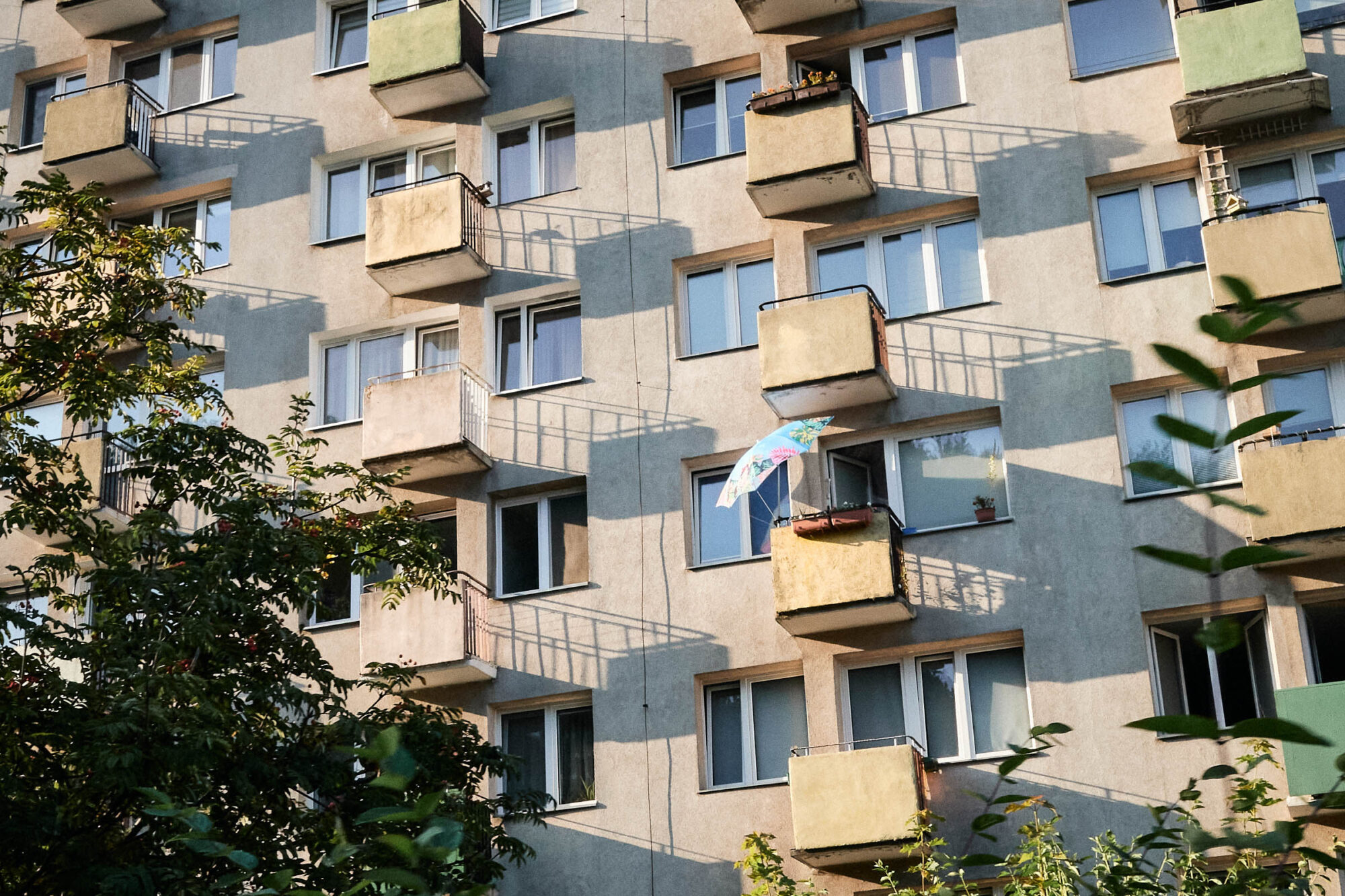
Poland joining the EU in 2004 marked an inflection point for Cumulus, granting them easier access to the lucrative Western European markets. They capitalized on their unique position with low cost of production and established relationships with suppliers in the Polish down industry. Jacek started in customer service and product development, his recommendations becoming part of the institutional wisdom of European ultralight communities. He’s since taken over the daily operations from his father, but Zdzisław remains active in the background, taking care of the people and organizing company trips. Today, the company counts around 40 employees, most of whom work in logistics and in-house manufacturing roles.
Product and Production
In the showroom, a loud red and blue sleeping bag with an old logo patch on matte nylon stands out among the current palette of shiny olive and anthracite. “We have people who bought their sleeping bag 25 years ago now coming back, and they know the new bag will fit the same,” explains Rafał. Cumulus’s signature—the contours, the fit, the baffle construction, the down stuffing, the material handling—was developed in the early years and has been stable since. The most significant improvement was the introduction of ultralight Pertex Quantum fabrics in the 2000s. Today, the sleeping bag is a mature product, and Cumulus has plenty of competitors with comparable offerings.

But Cumulus is not only ultralight sleeping bags. Outdoor people through and through, they offer minimal tarps, hammocks, jackets and other apparel, and they even made bike panniers at one point. They just introduced a line of four hardshells from ultralight to expedition-ready. It was produced nearby by a partner, like most of their other garments. They’re justifiably proud of this release; outdoor waterproofs made in Europe are almost unheard of. Experimental sleeping garments and backpacks are scattered throughout the office.
These samples are all made by Rafał, the main developer at Cumulus, bikepacker, and serial auto-didact. He’s quiet, kind, and curious, eager to try his hand at anything. “I made my first seat pack without any stiffeners because all I had was images from the internet. It was a very sad dry bag,” he says with a smile. He sewed bikepacking bags under his own label until 2010, as well as sleeping bags, tarps, backpacks, and tents for himself. This got his foot in the door at Cumulus nine years ago, and he’s since moved from customer service into his current product development and management role.
Greg takes me down the stairs into the factory floor, and we enter a rectangular main hall ringing with the chatter of two dozen sewing machines. It’s all women on the Jukis, mostly middle-aged. A few of them look up at me, curious. Toward the back, there’s a long cutting table and an equally long gantry laser cutter. Racks of raw materials line the hall, and human-sized cardboard patterns hang off the walls.
Filled sleeping bags are very bulky, so only a small number of the most popular models are kept in stock in the shipping room for immediate dispatch. To restock their shelf or fill an order of a less popular model, they pull an empty bag from a stack and send it into the production cycle. The baffles of the empty nylon shells are open on one side to receive their fill in the down room.
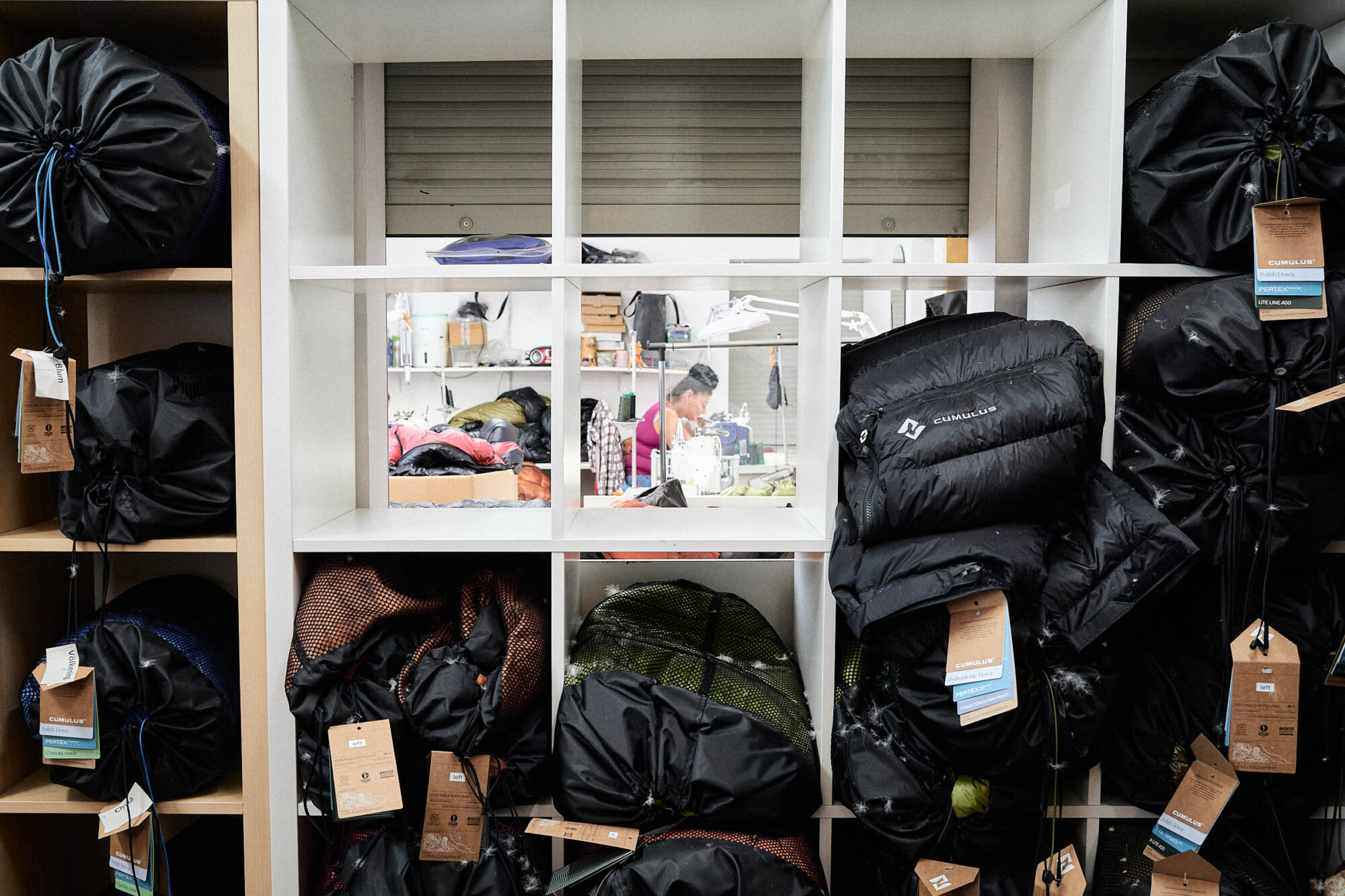
We step into the inside of a snow globe; down floats everywhere. An employee stuffs each baffle individually with the exact amount of down according to the model. A handful weighs nearly nothing; down is essentially air stabilized into a solid. The room is kept clean, and the free-floating fluff is collected with a shop vac at the end of the day. It goes into their low-grade filling, a simple yet effective way of ensuring that little of the precious material goes to waste.
A quick aside on down. Making up the soft under-plumage beneath the feathers, down clusters have the unparalleled ability to trap pockets of insulating air. The more air volume a given weight of down can occupy, the better the insulating effect. This is quantified by the down’s fluffiness, or fill power. All else being equal, the warmth of a garment or sleeping bag correlates positively with both the amount of down and the fill power contained. A fill power of 700 cubic inches is typical for general purposes, 800+ is used in ultralight gear, and 900+ is the choice for absolute weight weenies. While higher fill power is slightly lighter, a sleeping bag stuffed to the same loft with down of lower fill power will be just as warm and long-lived.
The down-filled bag is popped up through an opening in the wall to the next room, where the baffles are sewn shut and hang tags are added. Finally, the bag is cleaned with a blast of high-pressure air and stored in a mesh storage bag, ready to go into the world. They ship out several dozen bags per day, varying by season. The lead time for a stock model can be as little as one day.
And the laser cutter? Cumulus offers full customization of most of their models, including length, width, zipper side, fill power, overfill, and distribution. The laser cutter is used to slice a single ply of ultralight fabric into all the parts of the custom sleeping bag (or quilt) with millimeter precision, saving lots of time, labor, and opportunities for errors. The individual pieces are then sewn together into a sleeping bag shell filled with down according to the custom order. It takes considerable skill to work efficiently with these ultrathin materials, and it also requires special sewing machine transports, needles, and thread determined through trial and error over the decades. They are shy about sharing these hard-won details.
Effectively, Cumulus has implemented an efficient pull-production system with low inventory and smooth flow through the facility, which is impressive considering their large mix of stock and custom models. The ultralight mentality and lean manufacturing could be said to share a philosophical base of reducing waste. Minimizing weight requires quality in construction and materials because there’s no excess fabric or unnecessary stitches. Similarly, manufacturing on demand and reducing buffers reveals any production problems so they can be eliminated through better organization or technology.
It’s mostly middle-aged women on the machines because young people in Poland (and the rest of Europe) don’t dream of taking these kinds of unglamorous manufacturing jobs. The lack of skilled workers is an ongoing crisis in European manufacturing, particularly in the textile industry. Cumulus isn’t as strongly affected yet; the employees stick with the company. Cumulus used to pay above average, though the wages in the sector have increased recently, as have the costs of living. Zdzisław works in the background to keep folks happy and organizes several company-wide camping trips annually. They’ve been to Sweden, Norway, the Tatra Mountains, and all over Poland. For many of the women in production, these outings were their wild camping experiences, supported by their work friends and the equipment they made. It sounds very wholesome.
Two decades after Poland’s accession to the EU, post-inflation, with rising costs of labor and materials, Cumulus products aren’t the screaming deal they used to be. This is the moment when a company might consider outsourcing to the new economic periphery in Europe: Ukraine and the Balkans. At Cumulus, they currently have no such plans. “We feel good about producing in Poland. We are an exception, and that makes us happy,” Jacek says.
The ethics of down
Commercial down is a byproduct of duck and goose farming. “Without meat, there is no down,” says Rafał—at least not at the low prices we’re used to. I was a bit shocked to learn my quilt contains the down of around a dozen geese, more than I guessed. Its €300 price tag suddenly seems too cheap for their sacrifice. The folks at Cumulus team got visibly uncomfortable on this subject, which is probably a healthy response.

Yet synthetic insulation is also problematic on several levels. Since recycling is far from perfect, the polymer fibers eventually enter the environment as harmful microplastics, the consequences of which we’re only beginning to understand. Plastic pollution is exacerbated by the much shorter useful lifespan of synthetic garments. It’s a more diffuse, long-term harm than animal exploitation, but it’s undeniably real. As a petroleum product, synthetics subsidize an extractive industry that’s burning our planet. Plant-based, biodegradable insulation may present a partial solution but is unlikely to match the performance and longevity of bird down.
Animal welfare has been a concern in the down supply chain for some time. Following pressure from activist groups around 2010, big players like Patagonia and The North Face started cleaning up their down supply chains. This led to the development of the Responsible Down Standard (RDS), which certifies that the birds supplying the down are treated humanely and not subjected to unnecessary suffering. In the EU, live-plucking is illegal, and according to Allied Feather, generally not a risk for goose down from meat production. Force-feeding is illegal in most EU member states, including Poland.
Polish down production is the third-largest in the world by revenue, and Cumulus sources their down from the two largest Polish collector-based suppliers. Cumulus expects to receive their RDS certification soon, noting that their down will continue to come from the same RDS-certified supplier they’ve been trusting all along. Given Cumulus’s long-standing commitment to humane down sourcing, getting the official badge appears to be a formality.
I find it quite impressive to see big outdoor manufacturers rolling out sweeping standards within a few short years—no small feat given the distributed, opaque, small-scale of the down supply chain. It shows the significant power they have to effect change when prompted. Still, I must say, certain brands, including Cumulus, calling their down ethical seems like whitewashing to me. Whether down or synthetic, both are far from what I would call “ethical.” There’s no ethical consumption under capitalism, and even the most “responsible” standards yield some level of suffering. Perhaps the closest thing to ethical down is Icelandic eiderdown, gathered from the nests of the wild eider duck. A duvet goes for several thousand dollars.
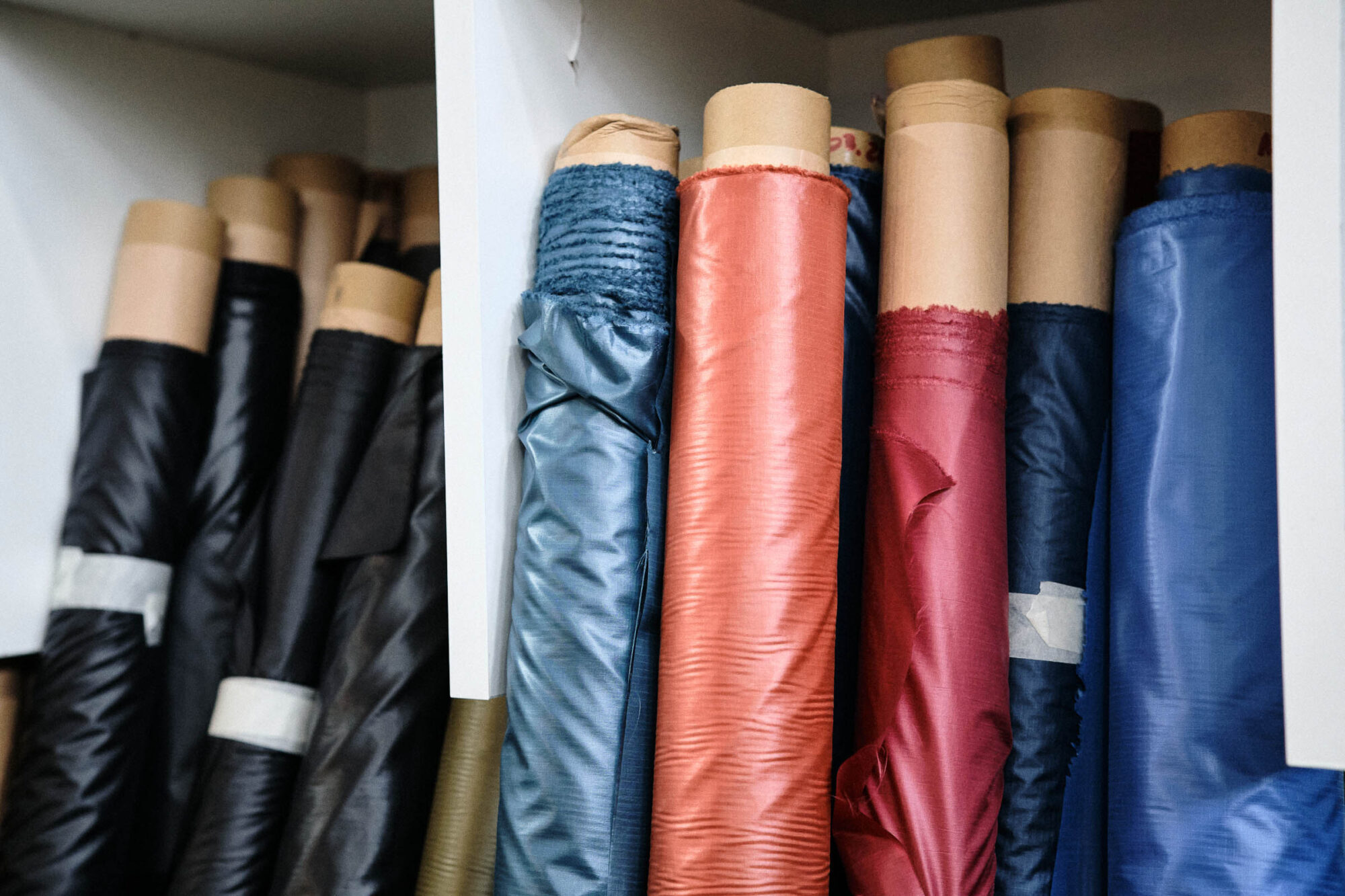
Without diminishing the ethical and sustainability concerns nor the progress achieved by activist groups, small family-owned manufacturers, and the down industry at large, I think it comes down to preference for consumers. The impact of buying a quality item of clothing every few years pales in comparison to the costs of flying somewhere for a few weeks of bikepacking, never mind the material and energy needs of the services and systems we rely on every single day.
I appreciate the supreme longevity and performance that down offers. “Down we can wash, we can refill it. Synthetics, we can‘t do much,” Rafał explains. And the natural material speaks to me in other ways. Beyond re-using, repairing, and reducing, beyond refusing marketing and rethinking our needs and organizing ourselves, I wonder if we must re-imagine our relationship with the apparently inert objects we use. I feel natural materials can help with remembering the life contained within them more so than their hyperindustrial synthetic counterparts. It’s more alive. I’m now more attentive to how I treat my down gear, and I finally got my quilt professionally washed.
Time Out
At the end of a packed day, my head feels like a stuff sack that’s a size too small. After devouring an excellent Neapolitan-style pizza in the city center, Rafał and I head for the hills for a mid-week overnighter. Five minutes off the main drag, we crest into a young beech forest, and the roar of traffic subsides. Outside at last. We breathe. On the dirt lanes between farms and fields, our conversation ranges further. Rafał’s cyclocross experience shows as he easily clears the rocky, rutted pitches while we chat.

I infer he’s one of the old-school bikepackers in Poland. “There were two other guys that I knew of [in Poland], and we met up to discuss kits. Cutting toothbrushes in half, stuff like that,” he reflects. This was back in 2006; he had a popular blog chronicling his adventures and gear lists. He’s toured the periphery of the country, completed week-long ultras, and crossed Iceland’s Highlands on a fatbike. Lately, he’s been challenging himself in other ways, hiking with his wife and SCUBA diving in the countless lakes of Kashubia.
Before I know it, Rafał shoots off the dirt road down a twisty path, and we pop out at a perfectly still round lake. Surrounded by tall pines and birches, it’s a hidden oasis that reminds me of Scandinavia. We strip off and send ripples into the faintly golden water. It never fails to surprise me how restorative a bike ride and a swim can be. Rafał shows me the Cumulus hammock system he designed, modestly noting that it merely adapts existing designs. Jacek hikes in, bringing cold beer and sausages we fry over a fire. He warms up, and we do what you do: watch the flames and trade stories of underestimating mountains. I sleep well.
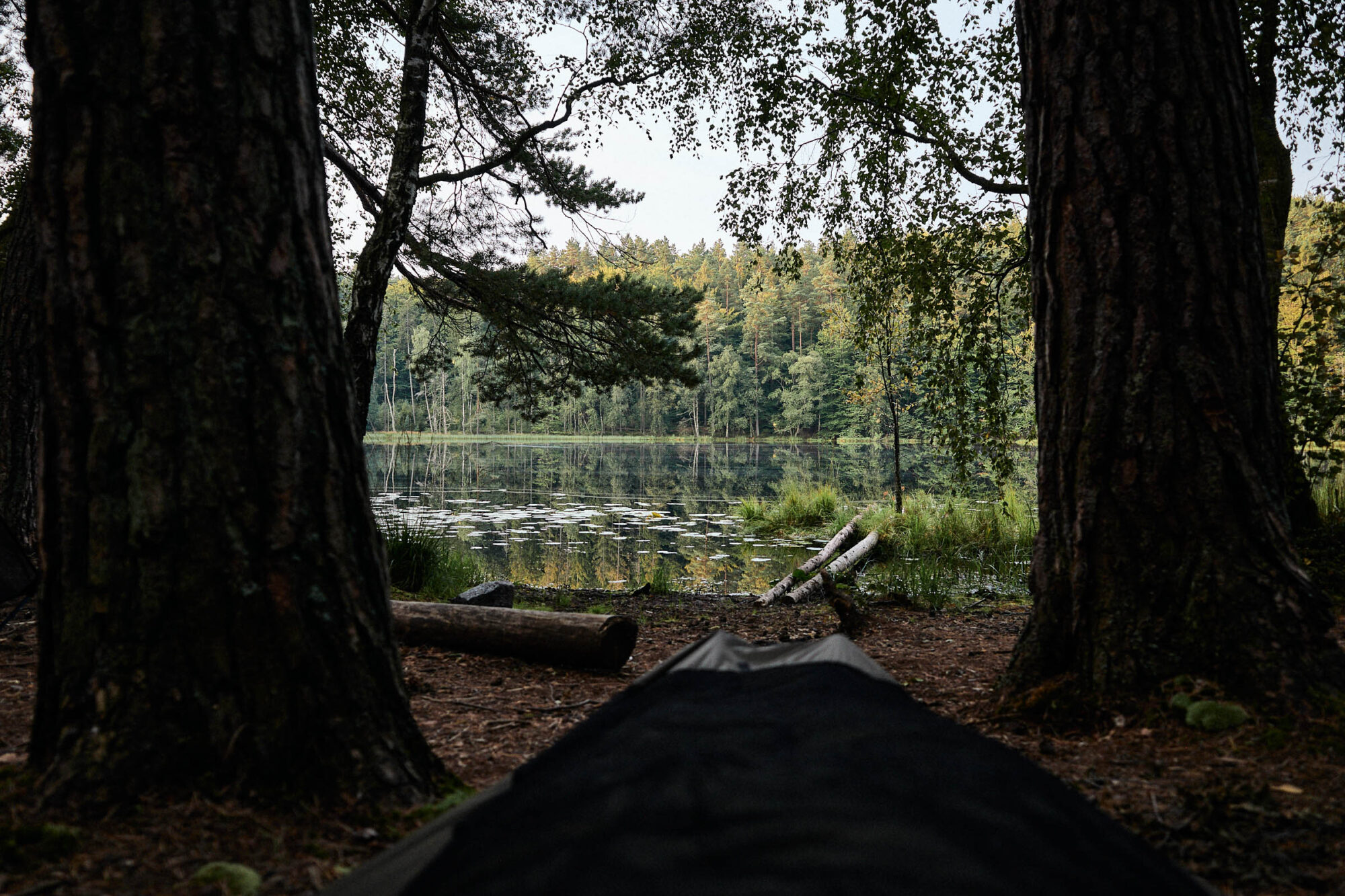
In the morning, we swim again, make coffee and breakfast, then ride back to Gdynia. We glide through the warm beech forest, dappled by the sun. The overstory is quiet, just the crunch of our tires and the whirring of our freehubs. After many years in the city, Rafał recently moved to the countryside. Today, I get to share with him the best commute in the world.
The Value of Local
Back in Gdynia, I have a few more hours to poke around the Cumulus office. After trying out some puffy jackets and sweating into a winter sleeping bag, my attention turns back to the colorful 25-year-old down bag due for an overhaul.
Nic Morales recently started a lively discussion on the complex question of local manufacturing in the USA. I want to offer a pragmatic reason for why it makes sense to buy from companies that are local to you and own their production. Retaining production capabilities in-house means companies like Cumulus can support and repair their products for decades to come. In contrast, companies that outsource their production far removed from their base are often restricted in their responses to product issues, typically opting to replace over repair.
While larger brands in the outdoor industry are generally pretty good at offering repairs, there are plenty of negative outliers. For example, Sea to Summit had me slash my otherwise intact air mat, and Wahoo requires what they euphemistically call a “field retire” that involves brutalizing the device with a screwdriver before sending out a voucher code, even if it’s just a defective air valve or battery that could easily be professionally fixed.
While these prematurely discarded luxury consumer objects may not account for much in the grand scheme of global waste streams, the replace-over-repair business model seems plainly unsustainable and irresponsible. It reinforces a throwaway culture that has no future. At the very least, such practices point to perverse economic incentives and an unsustainable system of accounting that systematically externalizes costs onto people and ecosystems in the Global South.

Even thinking purely as a cost-sensitive consumer, such unethical practices do us no favors. In these cases, we pay inflated sticker prices for sub-par products because the expected replacement cost is already priced in. As time goes on and the cheap gear I bought on a student budget starts to irreparably fail, I’m realizing I’d rather enjoy longer-lasting products and guaranteed manufacturer support if I’m buying new luxury goods. I want to be like Lauri, rocking some of the gear I started bikepacking with, made more meaningful by patches and patina and many adventures. Buying new all the time has lost its luster.
While less quantifiable, local means I can ride to the place, understanding in my body the energy it takes just for the object to reach me. I can, at least in theory, meet the folks on the machines performing the crucial labor I wouldn’t want to do. I can get a sense of the organization and resources that enable my lifestyle and get a better idea of the true cost. Finally, there’s the possibility of connecting and reflecting with competent and committed people like Jacek and Rafał and Anna and Grzegorz and the opportunity to hear their perspectives, achievements, flaws, and constraints. It’s the chance to ride bikes together and have a more meaningful relationship.
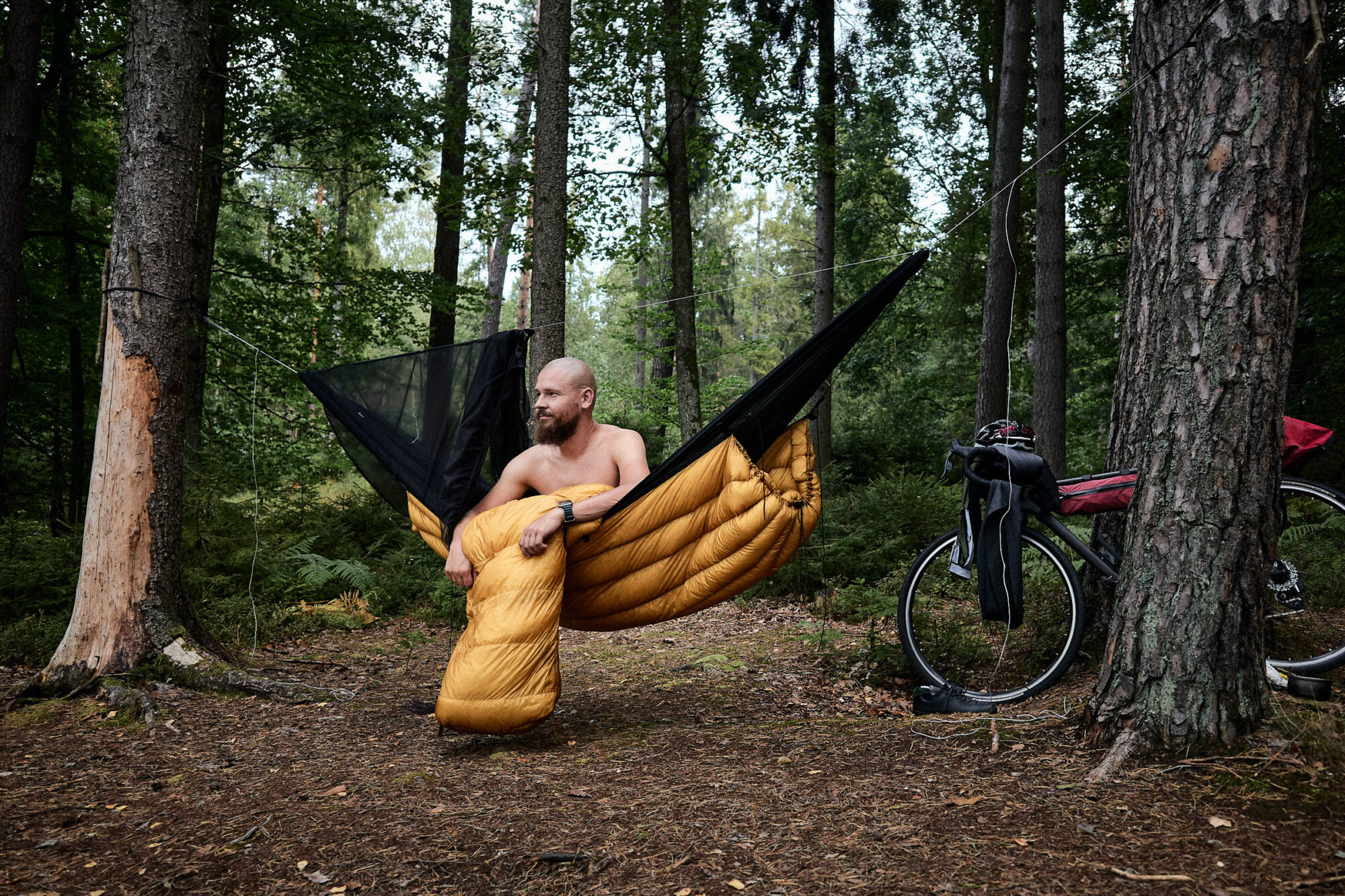
Snuggling into my quilt, sometimes but not often enough, I think of the geese who gave their life and the farm workers and the women at Cumulus sewing the down into my quilt. It’s the product of all that life and more. It reliably keeps me warm, and I feel a heavy sort of gratitude.
You can browse the full range of Cumulus sleeping bags, jackets, and more at Cumulus.Equipment.
Further Reading
Make sure to dig into these related articles for more info...
Please keep the conversation civil, constructive, and inclusive, or your comment will be removed.
